Introduction to Research Literature Review
VerifiedAdded on 2021/06/14
|21
|4025
|188
AI Summary
Introduction to Research Literature Review By : [To be added by student] Student Id: [To be added by student] Chapter 1 3 Literature Review 3 1.1 Broad Scanning 4 1.1.1 Research Journal 4 1.1.2 Filing Journal 6 1.1.3 Bibliographic Information of chosen papers 7 1.2 Focused review 9 1.2.1 Updated filing System 9 1.2.2 Update Bibliographic Information of chosen papers 10/09/2018 1.3 Data Mining Methods for Crime Detection 11 1.3.1 Identity Crime 12 1.3.2 Overview of Data Mining 13 1.
Contribute Materials
Your contribution can guide someone’s learning journey. Share your
documents today.
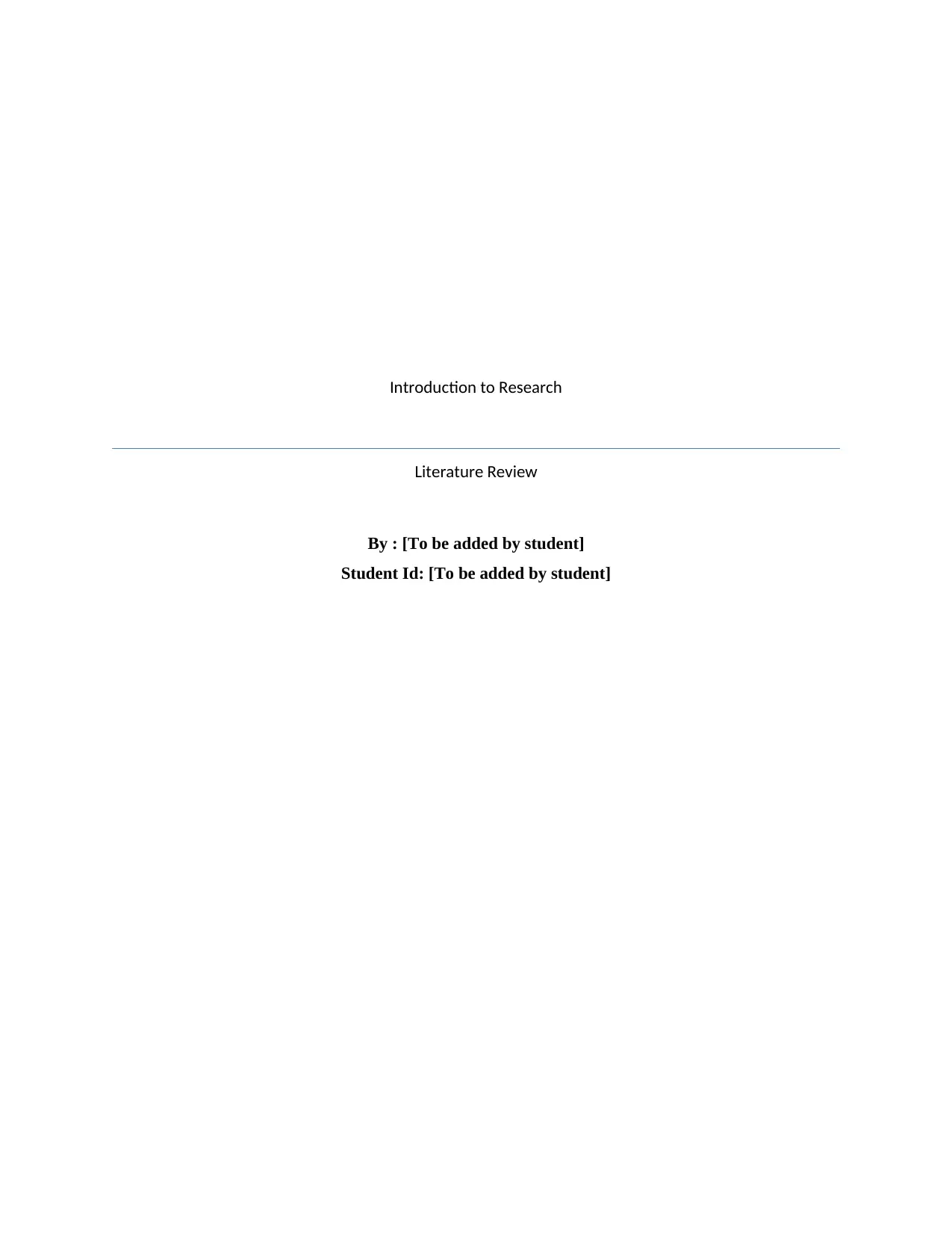
Introduction to Research
Literature Review
By : [To be added by student]
Student Id: [To be added by student]
Literature Review
By : [To be added by student]
Student Id: [To be added by student]
Secure Best Marks with AI Grader
Need help grading? Try our AI Grader for instant feedback on your assignments.
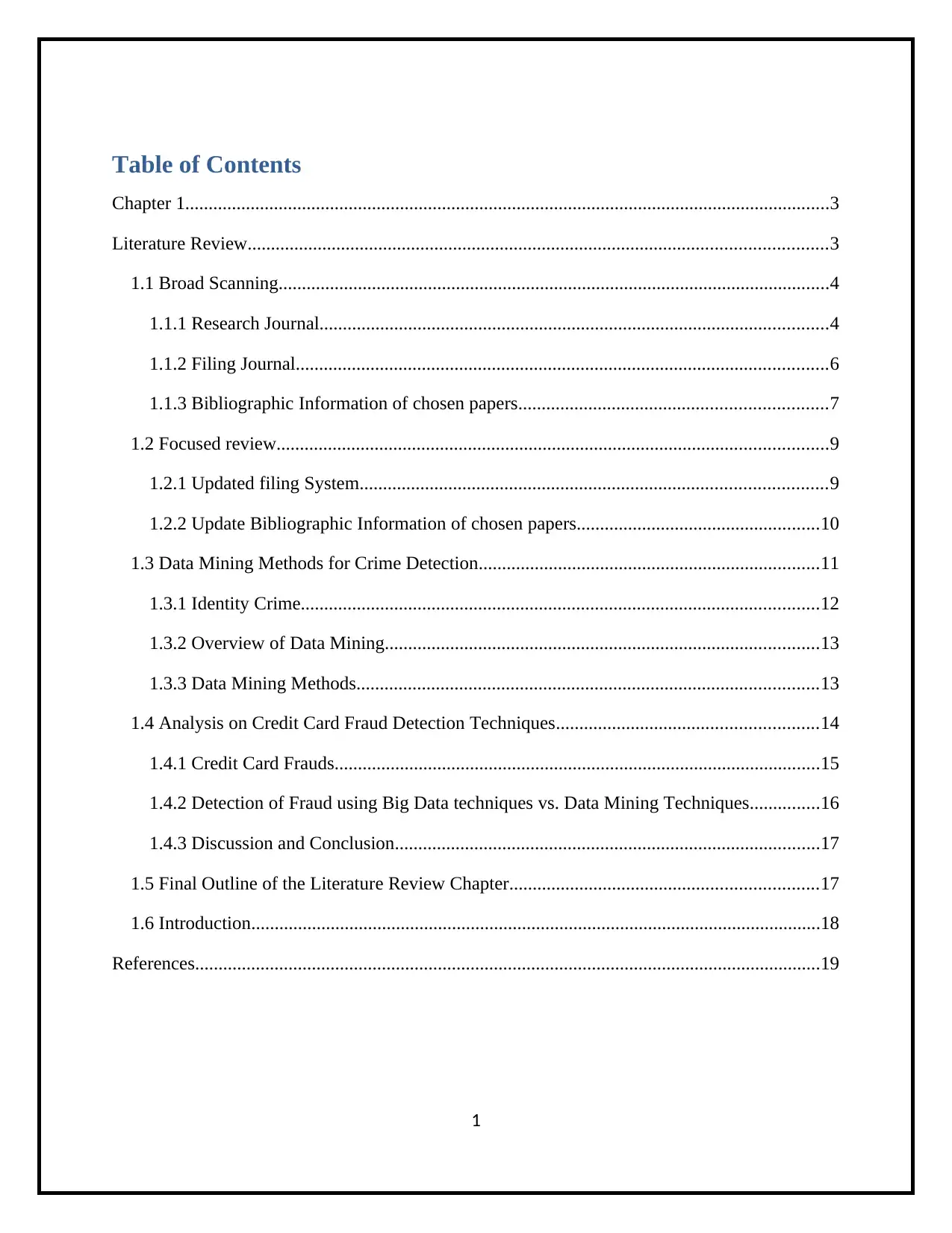
Table of Contents
Chapter 1..........................................................................................................................................3
Literature Review............................................................................................................................3
1.1 Broad Scanning......................................................................................................................4
1.1.1 Research Journal.............................................................................................................4
1.1.2 Filing Journal..................................................................................................................6
1.1.3 Bibliographic Information of chosen papers..................................................................7
1.2 Focused review......................................................................................................................9
1.2.1 Updated filing System....................................................................................................9
1.2.2 Update Bibliographic Information of chosen papers....................................................10
1.3 Data Mining Methods for Crime Detection.........................................................................11
1.3.1 Identity Crime...............................................................................................................12
1.3.2 Overview of Data Mining.............................................................................................13
1.3.3 Data Mining Methods...................................................................................................13
1.4 Analysis on Credit Card Fraud Detection Techniques........................................................14
1.4.1 Credit Card Frauds........................................................................................................15
1.4.2 Detection of Fraud using Big Data techniques vs. Data Mining Techniques...............16
1.4.3 Discussion and Conclusion...........................................................................................17
1.5 Final Outline of the Literature Review Chapter..................................................................17
1.6 Introduction..........................................................................................................................18
References......................................................................................................................................19
1
Chapter 1..........................................................................................................................................3
Literature Review............................................................................................................................3
1.1 Broad Scanning......................................................................................................................4
1.1.1 Research Journal.............................................................................................................4
1.1.2 Filing Journal..................................................................................................................6
1.1.3 Bibliographic Information of chosen papers..................................................................7
1.2 Focused review......................................................................................................................9
1.2.1 Updated filing System....................................................................................................9
1.2.2 Update Bibliographic Information of chosen papers....................................................10
1.3 Data Mining Methods for Crime Detection.........................................................................11
1.3.1 Identity Crime...............................................................................................................12
1.3.2 Overview of Data Mining.............................................................................................13
1.3.3 Data Mining Methods...................................................................................................13
1.4 Analysis on Credit Card Fraud Detection Techniques........................................................14
1.4.1 Credit Card Frauds........................................................................................................15
1.4.2 Detection of Fraud using Big Data techniques vs. Data Mining Techniques...............16
1.4.3 Discussion and Conclusion...........................................................................................17
1.5 Final Outline of the Literature Review Chapter..................................................................17
1.6 Introduction..........................................................................................................................18
References......................................................................................................................................19
1
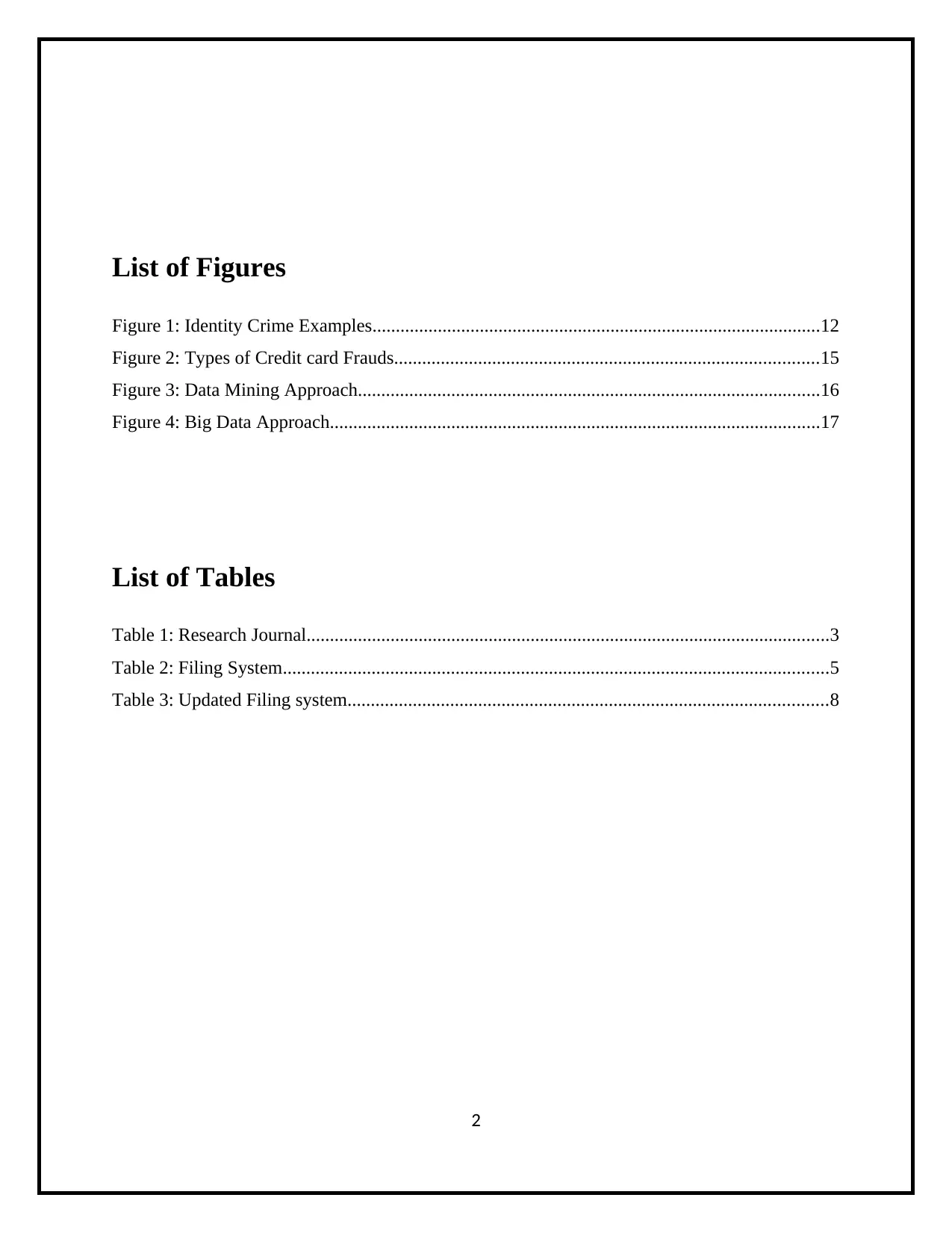
List of Figures
Figure 1: Identity Crime Examples................................................................................................12
Figure 2: Types of Credit card Frauds...........................................................................................15
Figure 3: Data Mining Approach...................................................................................................16
Figure 4: Big Data Approach.........................................................................................................17
List of Tables
Table 1: Research Journal................................................................................................................3
Table 2: Filing System.....................................................................................................................5
Table 3: Updated Filing system.......................................................................................................8
2
Figure 1: Identity Crime Examples................................................................................................12
Figure 2: Types of Credit card Frauds...........................................................................................15
Figure 3: Data Mining Approach...................................................................................................16
Figure 4: Big Data Approach.........................................................................................................17
List of Tables
Table 1: Research Journal................................................................................................................3
Table 2: Filing System.....................................................................................................................5
Table 3: Updated Filing system.......................................................................................................8
2
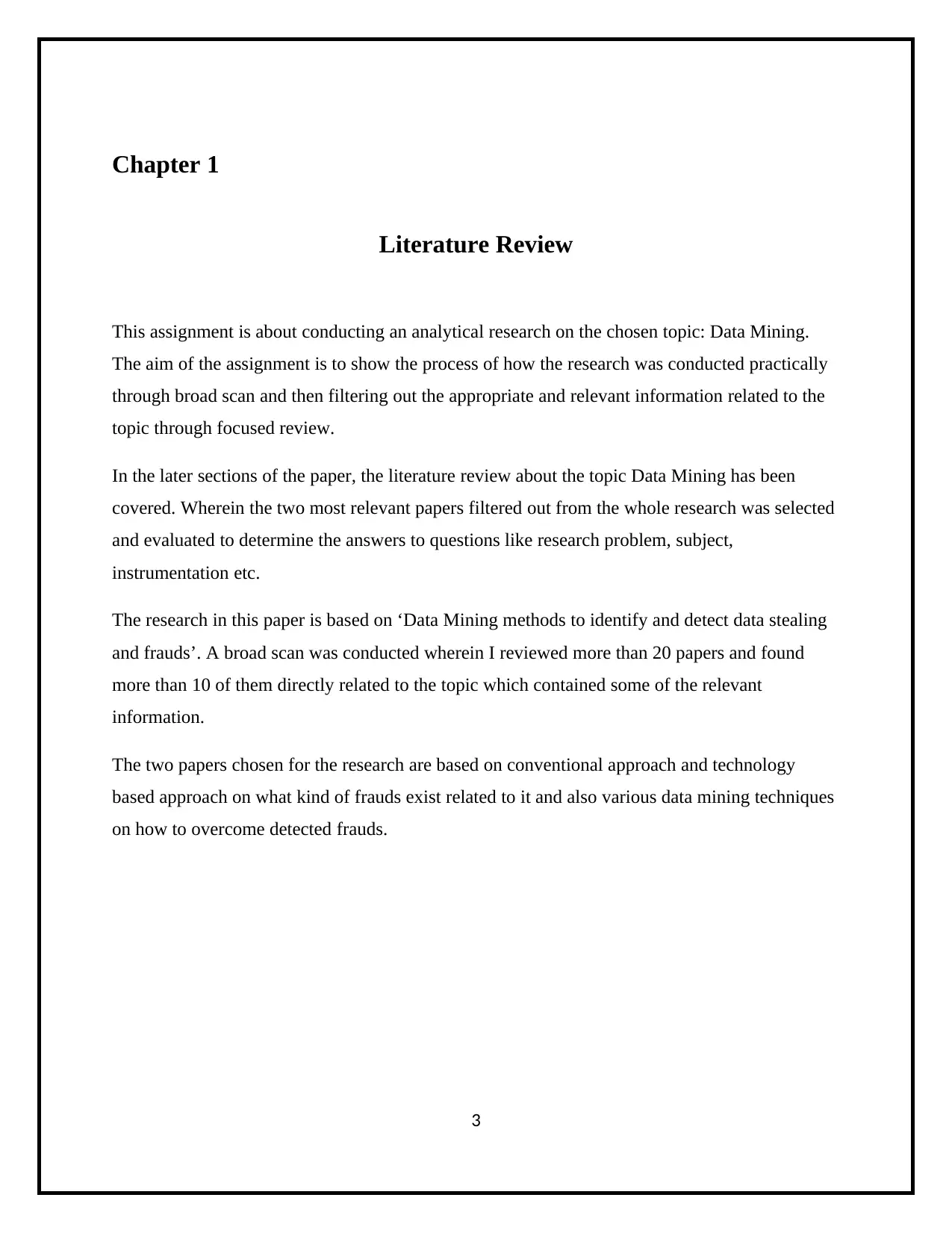
Chapter 1
Literature Review
This assignment is about conducting an analytical research on the chosen topic: Data Mining.
The aim of the assignment is to show the process of how the research was conducted practically
through broad scan and then filtering out the appropriate and relevant information related to the
topic through focused review.
In the later sections of the paper, the literature review about the topic Data Mining has been
covered. Wherein the two most relevant papers filtered out from the whole research was selected
and evaluated to determine the answers to questions like research problem, subject,
instrumentation etc.
The research in this paper is based on ‘Data Mining methods to identify and detect data stealing
and frauds’. A broad scan was conducted wherein I reviewed more than 20 papers and found
more than 10 of them directly related to the topic which contained some of the relevant
information.
The two papers chosen for the research are based on conventional approach and technology
based approach on what kind of frauds exist related to it and also various data mining techniques
on how to overcome detected frauds.
3
Literature Review
This assignment is about conducting an analytical research on the chosen topic: Data Mining.
The aim of the assignment is to show the process of how the research was conducted practically
through broad scan and then filtering out the appropriate and relevant information related to the
topic through focused review.
In the later sections of the paper, the literature review about the topic Data Mining has been
covered. Wherein the two most relevant papers filtered out from the whole research was selected
and evaluated to determine the answers to questions like research problem, subject,
instrumentation etc.
The research in this paper is based on ‘Data Mining methods to identify and detect data stealing
and frauds’. A broad scan was conducted wherein I reviewed more than 20 papers and found
more than 10 of them directly related to the topic which contained some of the relevant
information.
The two papers chosen for the research are based on conventional approach and technology
based approach on what kind of frauds exist related to it and also various data mining techniques
on how to overcome detected frauds.
3
Secure Best Marks with AI Grader
Need help grading? Try our AI Grader for instant feedback on your assignments.
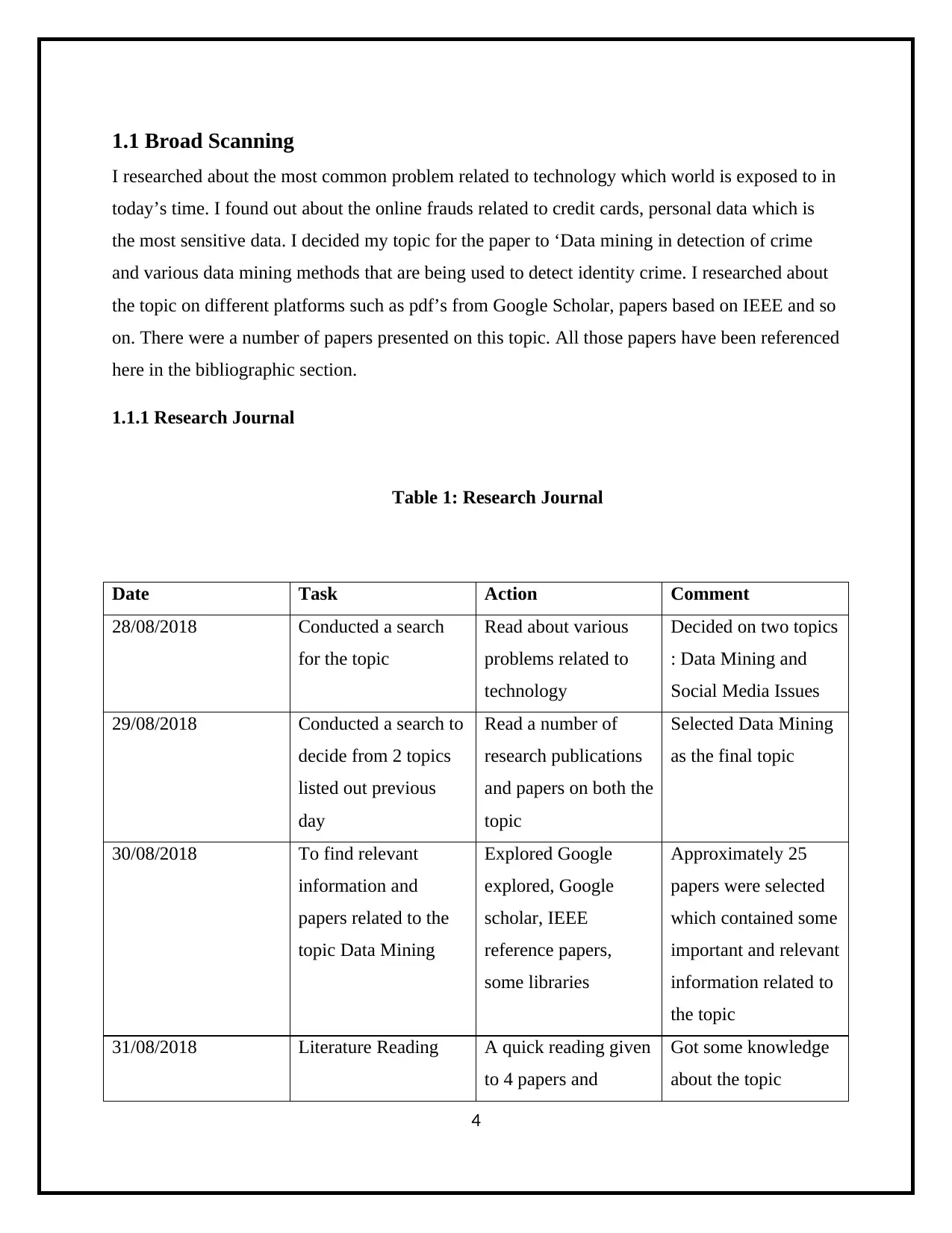
1.1 Broad Scanning
I researched about the most common problem related to technology which world is exposed to in
today’s time. I found out about the online frauds related to credit cards, personal data which is
the most sensitive data. I decided my topic for the paper to ‘Data mining in detection of crime
and various data mining methods that are being used to detect identity crime. I researched about
the topic on different platforms such as pdf’s from Google Scholar, papers based on IEEE and so
on. There were a number of papers presented on this topic. All those papers have been referenced
here in the bibliographic section.
1.1.1 Research Journal
Table 1: Research Journal
Date Task Action Comment
28/08/2018 Conducted a search
for the topic
Read about various
problems related to
technology
Decided on two topics
: Data Mining and
Social Media Issues
29/08/2018 Conducted a search to
decide from 2 topics
listed out previous
day
Read a number of
research publications
and papers on both the
topic
Selected Data Mining
as the final topic
30/08/2018 To find relevant
information and
papers related to the
topic Data Mining
Explored Google
explored, Google
scholar, IEEE
reference papers,
some libraries
Approximately 25
papers were selected
which contained some
important and relevant
information related to
the topic
31/08/2018 Literature Reading A quick reading given
to 4 papers and
Got some knowledge
about the topic
4
I researched about the most common problem related to technology which world is exposed to in
today’s time. I found out about the online frauds related to credit cards, personal data which is
the most sensitive data. I decided my topic for the paper to ‘Data mining in detection of crime
and various data mining methods that are being used to detect identity crime. I researched about
the topic on different platforms such as pdf’s from Google Scholar, papers based on IEEE and so
on. There were a number of papers presented on this topic. All those papers have been referenced
here in the bibliographic section.
1.1.1 Research Journal
Table 1: Research Journal
Date Task Action Comment
28/08/2018 Conducted a search
for the topic
Read about various
problems related to
technology
Decided on two topics
: Data Mining and
Social Media Issues
29/08/2018 Conducted a search to
decide from 2 topics
listed out previous
day
Read a number of
research publications
and papers on both the
topic
Selected Data Mining
as the final topic
30/08/2018 To find relevant
information and
papers related to the
topic Data Mining
Explored Google
explored, Google
scholar, IEEE
reference papers,
some libraries
Approximately 25
papers were selected
which contained some
important and relevant
information related to
the topic
31/08/2018 Literature Reading A quick reading given
to 4 papers and
Got some knowledge
about the topic
4
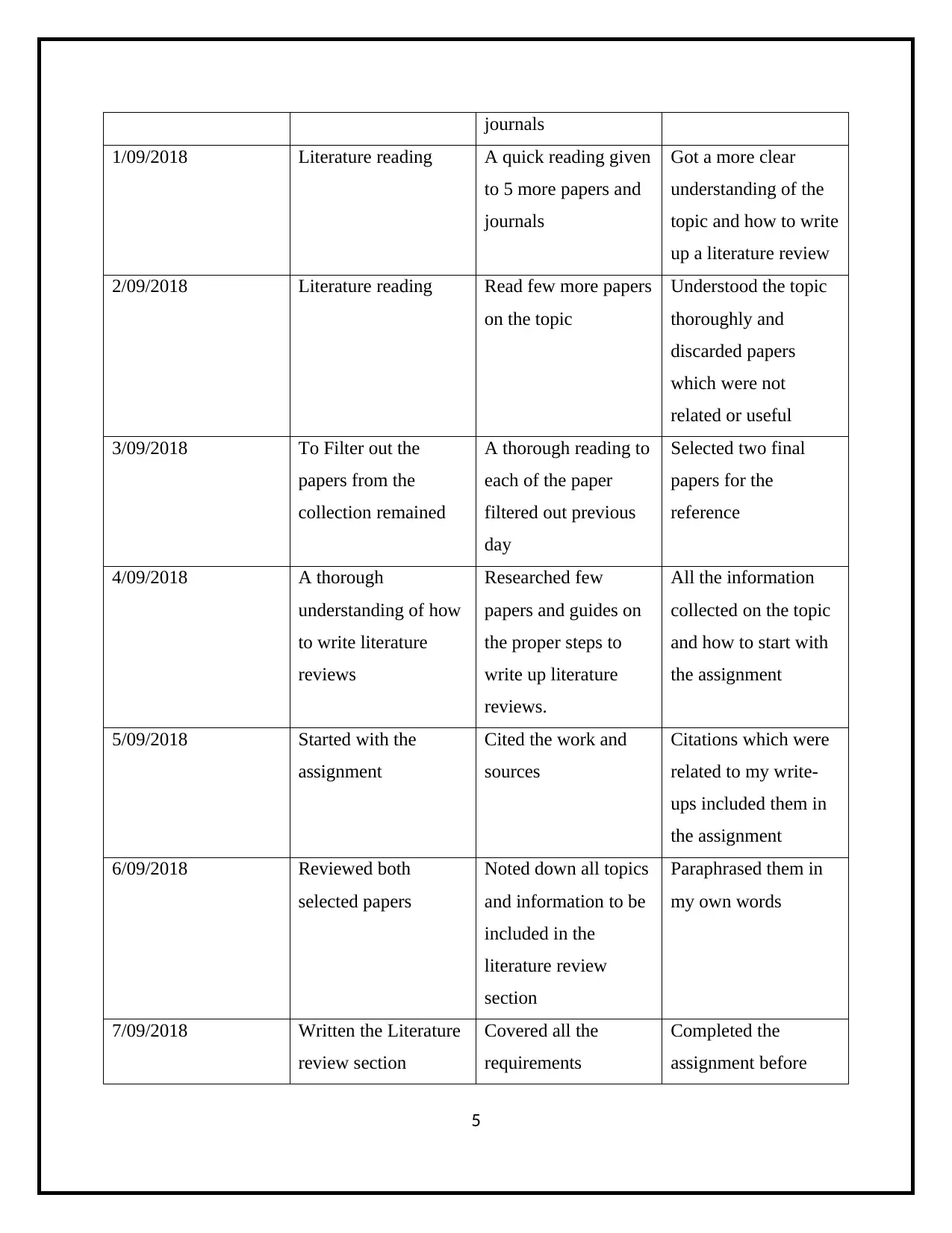
journals
1/09/2018 Literature reading A quick reading given
to 5 more papers and
journals
Got a more clear
understanding of the
topic and how to write
up a literature review
2/09/2018 Literature reading Read few more papers
on the topic
Understood the topic
thoroughly and
discarded papers
which were not
related or useful
3/09/2018 To Filter out the
papers from the
collection remained
A thorough reading to
each of the paper
filtered out previous
day
Selected two final
papers for the
reference
4/09/2018 A thorough
understanding of how
to write literature
reviews
Researched few
papers and guides on
the proper steps to
write up literature
reviews.
All the information
collected on the topic
and how to start with
the assignment
5/09/2018 Started with the
assignment
Cited the work and
sources
Citations which were
related to my write-
ups included them in
the assignment
6/09/2018 Reviewed both
selected papers
Noted down all topics
and information to be
included in the
literature review
section
Paraphrased them in
my own words
7/09/2018 Written the Literature
review section
Covered all the
requirements
Completed the
assignment before
5
1/09/2018 Literature reading A quick reading given
to 5 more papers and
journals
Got a more clear
understanding of the
topic and how to write
up a literature review
2/09/2018 Literature reading Read few more papers
on the topic
Understood the topic
thoroughly and
discarded papers
which were not
related or useful
3/09/2018 To Filter out the
papers from the
collection remained
A thorough reading to
each of the paper
filtered out previous
day
Selected two final
papers for the
reference
4/09/2018 A thorough
understanding of how
to write literature
reviews
Researched few
papers and guides on
the proper steps to
write up literature
reviews.
All the information
collected on the topic
and how to start with
the assignment
5/09/2018 Started with the
assignment
Cited the work and
sources
Citations which were
related to my write-
ups included them in
the assignment
6/09/2018 Reviewed both
selected papers
Noted down all topics
and information to be
included in the
literature review
section
Paraphrased them in
my own words
7/09/2018 Written the Literature
review section
Covered all the
requirements
Completed the
assignment before
5
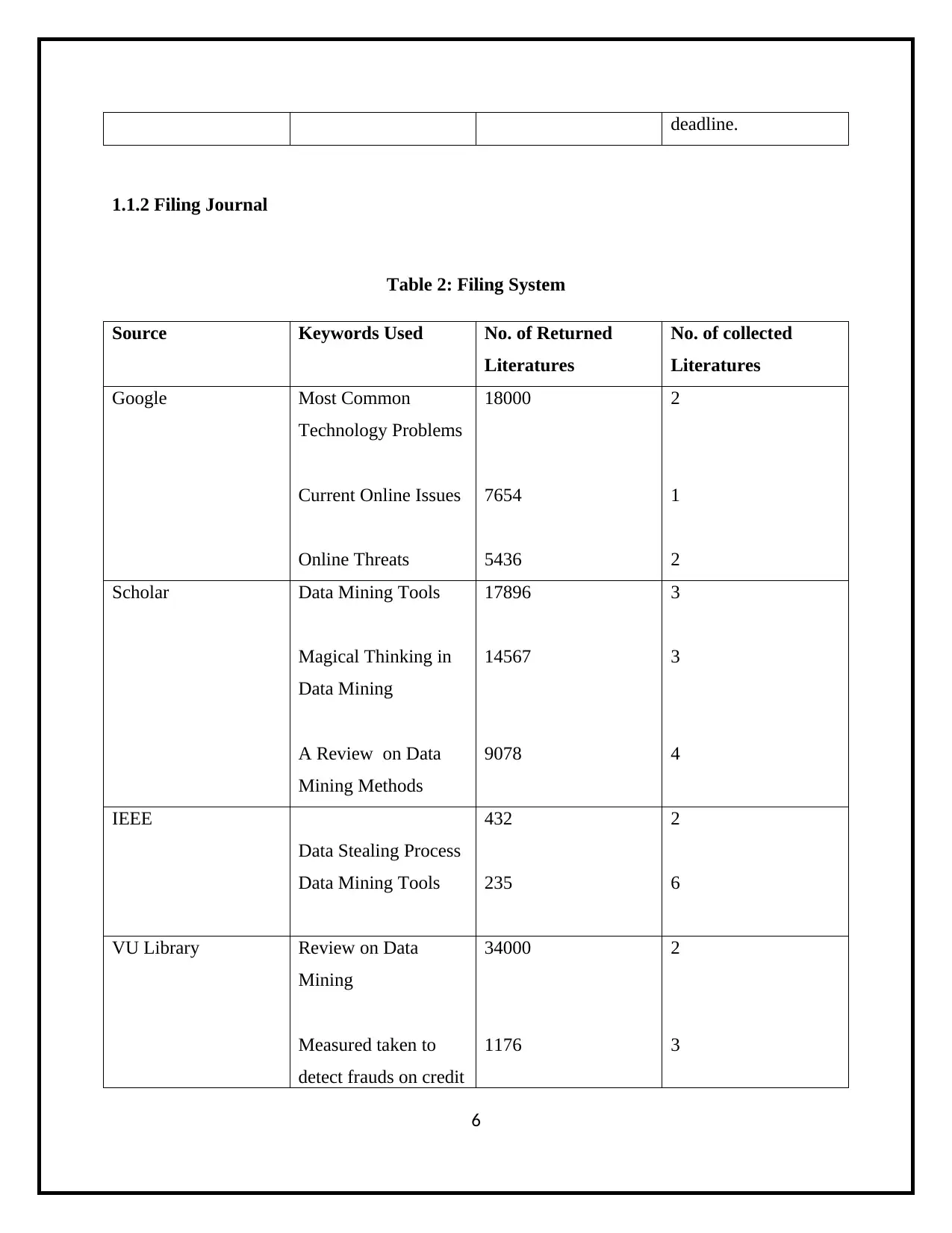
deadline.
1.1.2 Filing Journal
Table 2: Filing System
Source Keywords Used No. of Returned
Literatures
No. of collected
Literatures
Google Most Common
Technology Problems
Current Online Issues
Online Threats
18000
7654
5436
2
1
2
Scholar Data Mining Tools
Magical Thinking in
Data Mining
A Review on Data
Mining Methods
17896
14567
9078
3
3
4
IEEE
Data Stealing Process
Data Mining Tools
432
235
2
6
VU Library Review on Data
Mining
Measured taken to
detect frauds on credit
34000
1176
2
3
6
1.1.2 Filing Journal
Table 2: Filing System
Source Keywords Used No. of Returned
Literatures
No. of collected
Literatures
Google Most Common
Technology Problems
Current Online Issues
Online Threats
18000
7654
5436
2
1
2
Scholar Data Mining Tools
Magical Thinking in
Data Mining
A Review on Data
Mining Methods
17896
14567
9078
3
3
4
IEEE
Data Stealing Process
Data Mining Tools
432
235
2
6
VU Library Review on Data
Mining
Measured taken to
detect frauds on credit
34000
1176
2
3
6
Paraphrase This Document
Need a fresh take? Get an instant paraphrase of this document with our AI Paraphraser
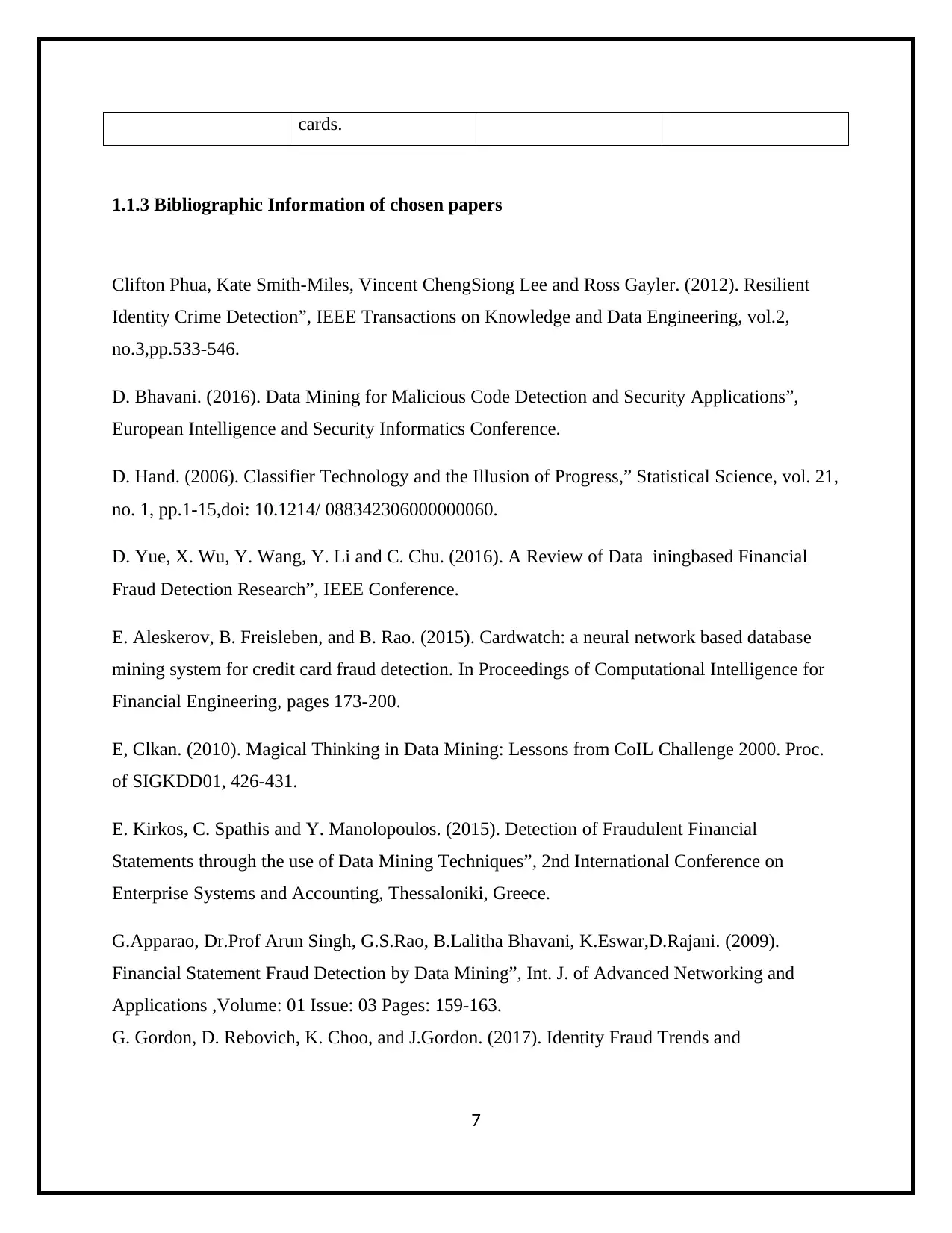
cards.
1.1.3 Bibliographic Information of chosen papers
Clifton Phua, Kate Smith-Miles, Vincent ChengSiong Lee and Ross Gayler. (2012). Resilient
Identity Crime Detection”, IEEE Transactions on Knowledge and Data Engineering, vol.2,
no.3,pp.533-546.
D. Bhavani. (2016). Data Mining for Malicious Code Detection and Security Applications”,
European Intelligence and Security Informatics Conference.
D. Hand. (2006). Classifier Technology and the Illusion of Progress,” Statistical Science, vol. 21,
no. 1, pp.1-15,doi: 10.1214/ 088342306000000060.
D. Yue, X. Wu, Y. Wang, Y. Li and C. Chu. (2016). A Review of Data iningbased Financial
Fraud Detection Research”, IEEE Conference.
E. Aleskerov, B. Freisleben, and B. Rao. (2015). Cardwatch: a neural network based database
mining system for credit card fraud detection. In Proceedings of Computational Intelligence for
Financial Engineering, pages 173-200.
E, Clkan. (2010). Magical Thinking in Data Mining: Lessons from CoIL Challenge 2000. Proc.
of SIGKDD01, 426-431.
E. Kirkos, C. Spathis and Y. Manolopoulos. (2015). Detection of Fraudulent Financial
Statements through the use of Data Mining Techniques”, 2nd International Conference on
Enterprise Systems and Accounting, Thessaloniki, Greece.
G.Apparao, Dr.Prof Arun Singh, G.S.Rao, B.Lalitha Bhavani, K.Eswar,D.Rajani. (2009).
Financial Statement Fraud Detection by Data Mining”, Int. J. of Advanced Networking and
Applications ,Volume: 01 Issue: 03 Pages: 159-163.
G. Gordon, D. Rebovich, K. Choo, and J.Gordon. (2017). Identity Fraud Trends and
7
1.1.3 Bibliographic Information of chosen papers
Clifton Phua, Kate Smith-Miles, Vincent ChengSiong Lee and Ross Gayler. (2012). Resilient
Identity Crime Detection”, IEEE Transactions on Knowledge and Data Engineering, vol.2,
no.3,pp.533-546.
D. Bhavani. (2016). Data Mining for Malicious Code Detection and Security Applications”,
European Intelligence and Security Informatics Conference.
D. Hand. (2006). Classifier Technology and the Illusion of Progress,” Statistical Science, vol. 21,
no. 1, pp.1-15,doi: 10.1214/ 088342306000000060.
D. Yue, X. Wu, Y. Wang, Y. Li and C. Chu. (2016). A Review of Data iningbased Financial
Fraud Detection Research”, IEEE Conference.
E. Aleskerov, B. Freisleben, and B. Rao. (2015). Cardwatch: a neural network based database
mining system for credit card fraud detection. In Proceedings of Computational Intelligence for
Financial Engineering, pages 173-200.
E, Clkan. (2010). Magical Thinking in Data Mining: Lessons from CoIL Challenge 2000. Proc.
of SIGKDD01, 426-431.
E. Kirkos, C. Spathis and Y. Manolopoulos. (2015). Detection of Fraudulent Financial
Statements through the use of Data Mining Techniques”, 2nd International Conference on
Enterprise Systems and Accounting, Thessaloniki, Greece.
G.Apparao, Dr.Prof Arun Singh, G.S.Rao, B.Lalitha Bhavani, K.Eswar,D.Rajani. (2009).
Financial Statement Fraud Detection by Data Mining”, Int. J. of Advanced Networking and
Applications ,Volume: 01 Issue: 03 Pages: 159-163.
G. Gordon, D. Rebovich, K. Choo, and J.Gordon. (2017). Identity Fraud Trends and
7
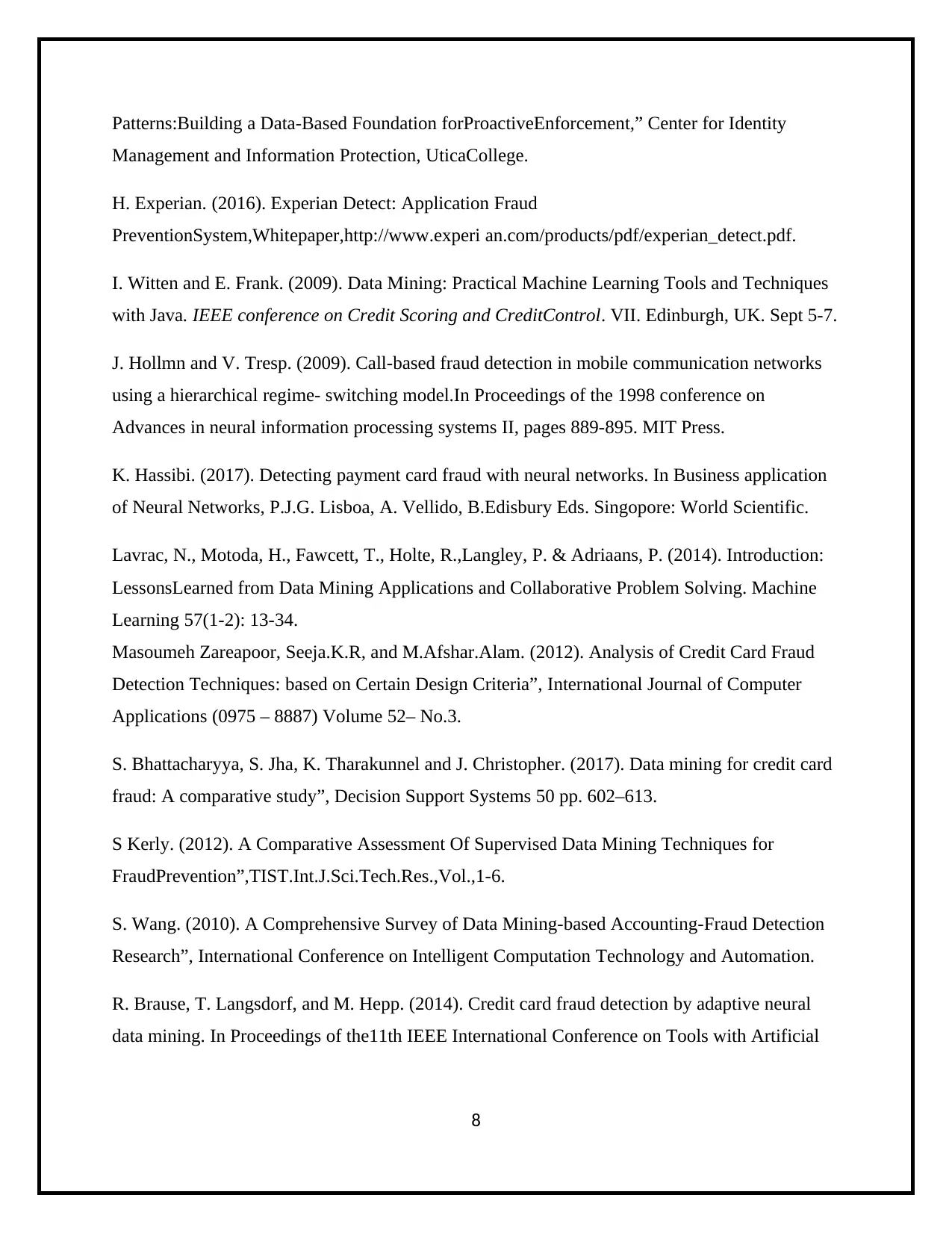
Patterns:Building a Data-Based Foundation forProactiveEnforcement,” Center for Identity
Management and Information Protection, UticaCollege.
H. Experian. (2016). Experian Detect: Application Fraud
PreventionSystem,Whitepaper,http://www.experi an.com/products/pdf/experian_detect.pdf.
I. Witten and E. Frank. (2009). Data Mining: Practical Machine Learning Tools and Techniques
with Java. IEEE conference on Credit Scoring and CreditControl. VII. Edinburgh, UK. Sept 5-7.
J. Hollmn and V. Tresp. (2009). Call-based fraud detection in mobile communication networks
using a hierarchical regime- switching model.In Proceedings of the 1998 conference on
Advances in neural information processing systems II, pages 889-895. MIT Press.
K. Hassibi. (2017). Detecting payment card fraud with neural networks. In Business application
of Neural Networks, P.J.G. Lisboa, A. Vellido, B.Edisbury Eds. Singopore: World Scientific.
Lavrac, N., Motoda, H., Fawcett, T., Holte, R.,Langley, P. & Adriaans, P. (2014). Introduction:
LessonsLearned from Data Mining Applications and Collaborative Problem Solving. Machine
Learning 57(1-2): 13-34.
Masoumeh Zareapoor, Seeja.K.R, and M.Afshar.Alam. (2012). Analysis of Credit Card Fraud
Detection Techniques: based on Certain Design Criteria”, International Journal of Computer
Applications (0975 – 8887) Volume 52– No.3.
S. Bhattacharyya, S. Jha, K. Tharakunnel and J. Christopher. (2017). Data mining for credit card
fraud: A comparative study”, Decision Support Systems 50 pp. 602–613.
S Kerly. (2012). A Comparative Assessment Of Supervised Data Mining Techniques for
FraudPrevention”,TIST.Int.J.Sci.Tech.Res.,Vol.,1-6.
S. Wang. (2010). A Comprehensive Survey of Data Mining-based Accounting-Fraud Detection
Research”, International Conference on Intelligent Computation Technology and Automation.
R. Brause, T. Langsdorf, and M. Hepp. (2014). Credit card fraud detection by adaptive neural
data mining. In Proceedings of the11th IEEE International Conference on Tools with Artificial
8
Management and Information Protection, UticaCollege.
H. Experian. (2016). Experian Detect: Application Fraud
PreventionSystem,Whitepaper,http://www.experi an.com/products/pdf/experian_detect.pdf.
I. Witten and E. Frank. (2009). Data Mining: Practical Machine Learning Tools and Techniques
with Java. IEEE conference on Credit Scoring and CreditControl. VII. Edinburgh, UK. Sept 5-7.
J. Hollmn and V. Tresp. (2009). Call-based fraud detection in mobile communication networks
using a hierarchical regime- switching model.In Proceedings of the 1998 conference on
Advances in neural information processing systems II, pages 889-895. MIT Press.
K. Hassibi. (2017). Detecting payment card fraud with neural networks. In Business application
of Neural Networks, P.J.G. Lisboa, A. Vellido, B.Edisbury Eds. Singopore: World Scientific.
Lavrac, N., Motoda, H., Fawcett, T., Holte, R.,Langley, P. & Adriaans, P. (2014). Introduction:
LessonsLearned from Data Mining Applications and Collaborative Problem Solving. Machine
Learning 57(1-2): 13-34.
Masoumeh Zareapoor, Seeja.K.R, and M.Afshar.Alam. (2012). Analysis of Credit Card Fraud
Detection Techniques: based on Certain Design Criteria”, International Journal of Computer
Applications (0975 – 8887) Volume 52– No.3.
S. Bhattacharyya, S. Jha, K. Tharakunnel and J. Christopher. (2017). Data mining for credit card
fraud: A comparative study”, Decision Support Systems 50 pp. 602–613.
S Kerly. (2012). A Comparative Assessment Of Supervised Data Mining Techniques for
FraudPrevention”,TIST.Int.J.Sci.Tech.Res.,Vol.,1-6.
S. Wang. (2010). A Comprehensive Survey of Data Mining-based Accounting-Fraud Detection
Research”, International Conference on Intelligent Computation Technology and Automation.
R. Brause, T. Langsdorf, and M. Hepp. (2014). Credit card fraud detection by adaptive neural
data mining. In Proceedings of the11th IEEE International Conference on Tools with Artificial
8
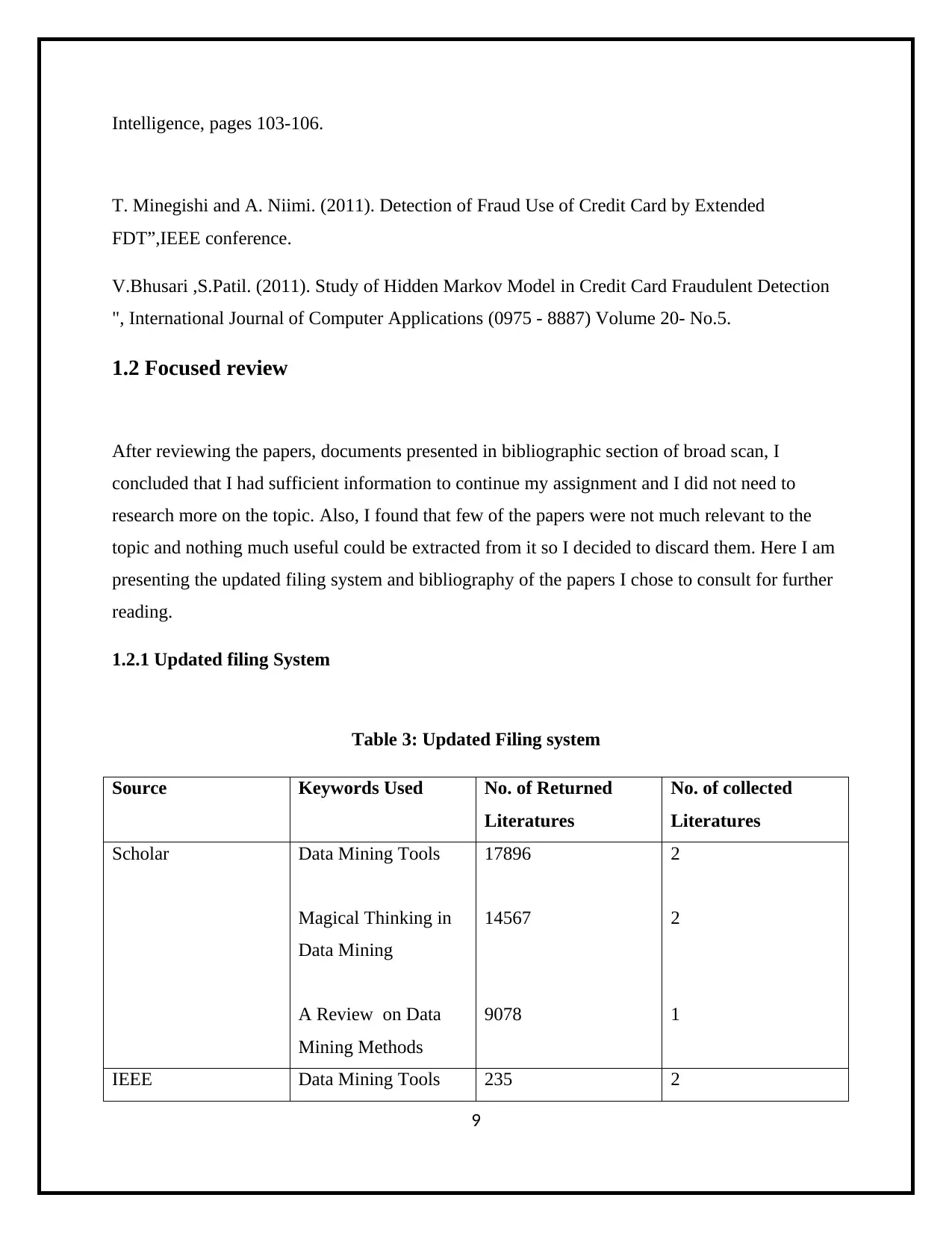
Intelligence, pages 103-106.
T. Minegishi and A. Niimi. (2011). Detection of Fraud Use of Credit Card by Extended
FDT”,IEEE conference.
V.Bhusari ,S.Patil. (2011). Study of Hidden Markov Model in Credit Card Fraudulent Detection
", International Journal of Computer Applications (0975 - 8887) Volume 20- No.5.
1.2 Focused review
After reviewing the papers, documents presented in bibliographic section of broad scan, I
concluded that I had sufficient information to continue my assignment and I did not need to
research more on the topic. Also, I found that few of the papers were not much relevant to the
topic and nothing much useful could be extracted from it so I decided to discard them. Here I am
presenting the updated filing system and bibliography of the papers I chose to consult for further
reading.
1.2.1 Updated filing System
Table 3: Updated Filing system
Source Keywords Used No. of Returned
Literatures
No. of collected
Literatures
Scholar Data Mining Tools
Magical Thinking in
Data Mining
A Review on Data
Mining Methods
17896
14567
9078
2
2
1
IEEE Data Mining Tools 235 2
9
T. Minegishi and A. Niimi. (2011). Detection of Fraud Use of Credit Card by Extended
FDT”,IEEE conference.
V.Bhusari ,S.Patil. (2011). Study of Hidden Markov Model in Credit Card Fraudulent Detection
", International Journal of Computer Applications (0975 - 8887) Volume 20- No.5.
1.2 Focused review
After reviewing the papers, documents presented in bibliographic section of broad scan, I
concluded that I had sufficient information to continue my assignment and I did not need to
research more on the topic. Also, I found that few of the papers were not much relevant to the
topic and nothing much useful could be extracted from it so I decided to discard them. Here I am
presenting the updated filing system and bibliography of the papers I chose to consult for further
reading.
1.2.1 Updated filing System
Table 3: Updated Filing system
Source Keywords Used No. of Returned
Literatures
No. of collected
Literatures
Scholar Data Mining Tools
Magical Thinking in
Data Mining
A Review on Data
Mining Methods
17896
14567
9078
2
2
1
IEEE Data Mining Tools 235 2
9
Secure Best Marks with AI Grader
Need help grading? Try our AI Grader for instant feedback on your assignments.
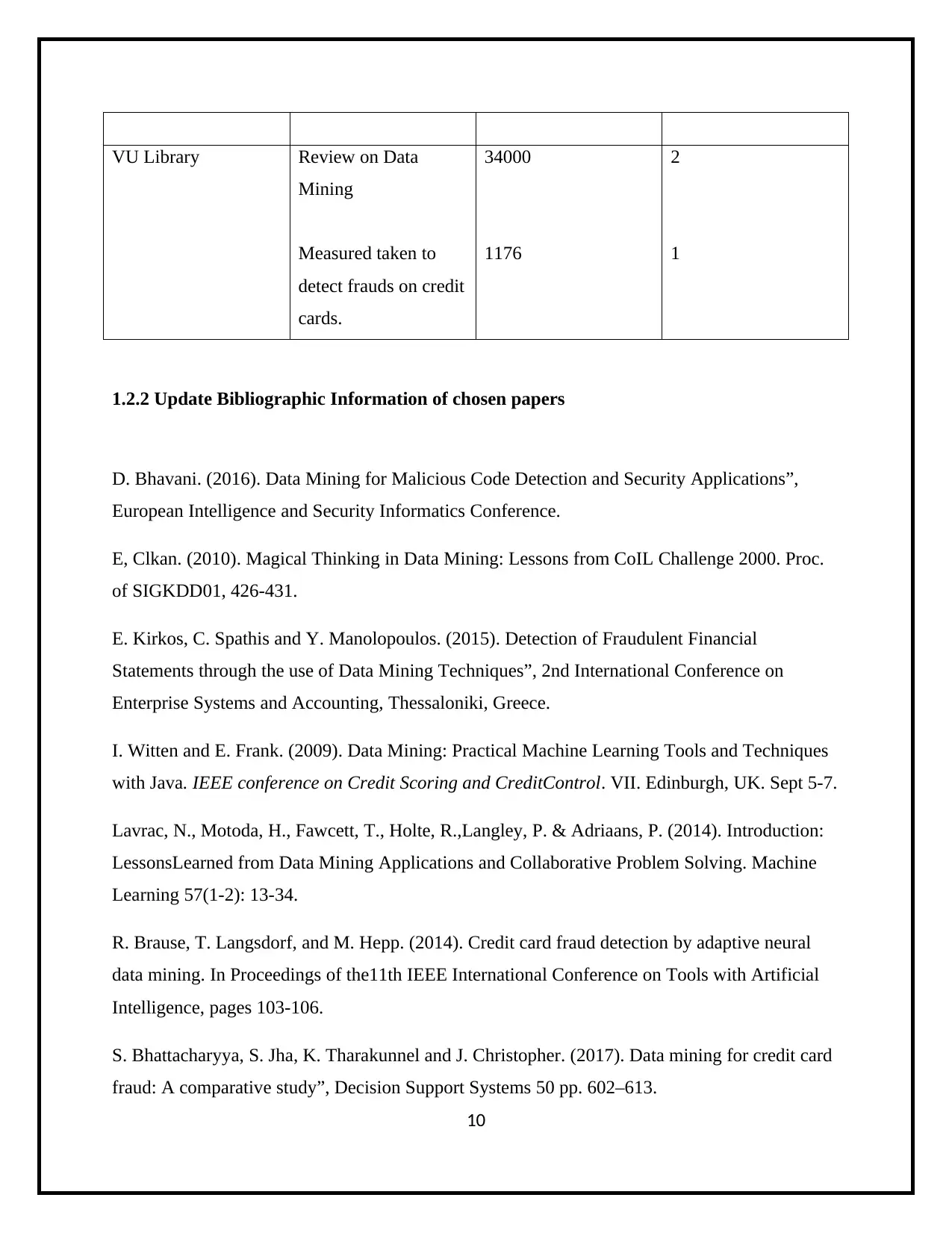
VU Library Review on Data
Mining
Measured taken to
detect frauds on credit
cards.
34000
1176
2
1
1.2.2 Update Bibliographic Information of chosen papers
D. Bhavani. (2016). Data Mining for Malicious Code Detection and Security Applications”,
European Intelligence and Security Informatics Conference.
E, Clkan. (2010). Magical Thinking in Data Mining: Lessons from CoIL Challenge 2000. Proc.
of SIGKDD01, 426-431.
E. Kirkos, C. Spathis and Y. Manolopoulos. (2015). Detection of Fraudulent Financial
Statements through the use of Data Mining Techniques”, 2nd International Conference on
Enterprise Systems and Accounting, Thessaloniki, Greece.
I. Witten and E. Frank. (2009). Data Mining: Practical Machine Learning Tools and Techniques
with Java. IEEE conference on Credit Scoring and CreditControl. VII. Edinburgh, UK. Sept 5-7.
Lavrac, N., Motoda, H., Fawcett, T., Holte, R.,Langley, P. & Adriaans, P. (2014). Introduction:
LessonsLearned from Data Mining Applications and Collaborative Problem Solving. Machine
Learning 57(1-2): 13-34.
R. Brause, T. Langsdorf, and M. Hepp. (2014). Credit card fraud detection by adaptive neural
data mining. In Proceedings of the11th IEEE International Conference on Tools with Artificial
Intelligence, pages 103-106.
S. Bhattacharyya, S. Jha, K. Tharakunnel and J. Christopher. (2017). Data mining for credit card
fraud: A comparative study”, Decision Support Systems 50 pp. 602–613.
10
Mining
Measured taken to
detect frauds on credit
cards.
34000
1176
2
1
1.2.2 Update Bibliographic Information of chosen papers
D. Bhavani. (2016). Data Mining for Malicious Code Detection and Security Applications”,
European Intelligence and Security Informatics Conference.
E, Clkan. (2010). Magical Thinking in Data Mining: Lessons from CoIL Challenge 2000. Proc.
of SIGKDD01, 426-431.
E. Kirkos, C. Spathis and Y. Manolopoulos. (2015). Detection of Fraudulent Financial
Statements through the use of Data Mining Techniques”, 2nd International Conference on
Enterprise Systems and Accounting, Thessaloniki, Greece.
I. Witten and E. Frank. (2009). Data Mining: Practical Machine Learning Tools and Techniques
with Java. IEEE conference on Credit Scoring and CreditControl. VII. Edinburgh, UK. Sept 5-7.
Lavrac, N., Motoda, H., Fawcett, T., Holte, R.,Langley, P. & Adriaans, P. (2014). Introduction:
LessonsLearned from Data Mining Applications and Collaborative Problem Solving. Machine
Learning 57(1-2): 13-34.
R. Brause, T. Langsdorf, and M. Hepp. (2014). Credit card fraud detection by adaptive neural
data mining. In Proceedings of the11th IEEE International Conference on Tools with Artificial
Intelligence, pages 103-106.
S. Bhattacharyya, S. Jha, K. Tharakunnel and J. Christopher. (2017). Data mining for credit card
fraud: A comparative study”, Decision Support Systems 50 pp. 602–613.
10
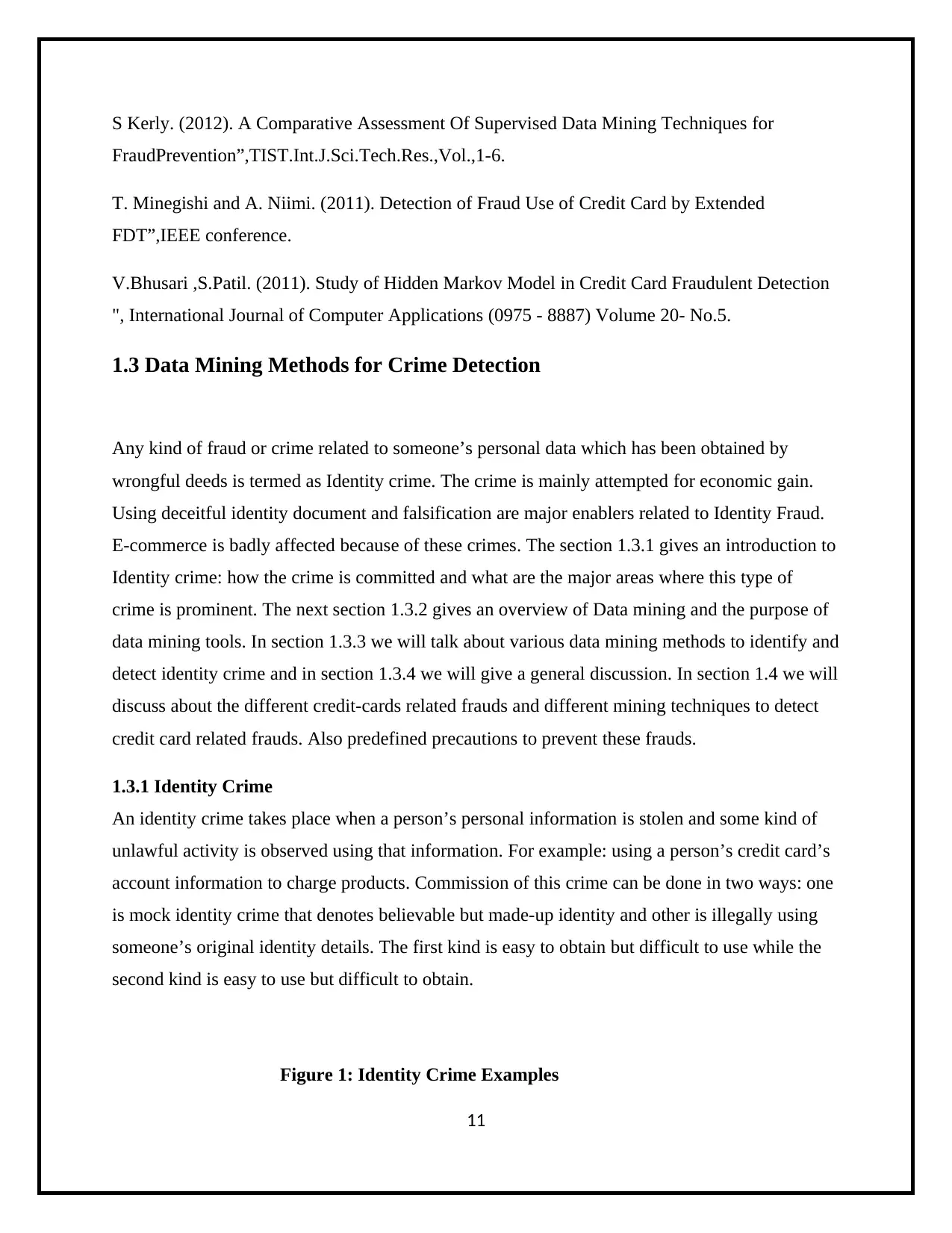
S Kerly. (2012). A Comparative Assessment Of Supervised Data Mining Techniques for
FraudPrevention”,TIST.Int.J.Sci.Tech.Res.,Vol.,1-6.
T. Minegishi and A. Niimi. (2011). Detection of Fraud Use of Credit Card by Extended
FDT”,IEEE conference.
V.Bhusari ,S.Patil. (2011). Study of Hidden Markov Model in Credit Card Fraudulent Detection
", International Journal of Computer Applications (0975 - 8887) Volume 20- No.5.
1.3 Data Mining Methods for Crime Detection
Any kind of fraud or crime related to someone’s personal data which has been obtained by
wrongful deeds is termed as Identity crime. The crime is mainly attempted for economic gain.
Using deceitful identity document and falsification are major enablers related to Identity Fraud.
E-commerce is badly affected because of these crimes. The section 1.3.1 gives an introduction to
Identity crime: how the crime is committed and what are the major areas where this type of
crime is prominent. The next section 1.3.2 gives an overview of Data mining and the purpose of
data mining tools. In section 1.3.3 we will talk about various data mining methods to identify and
detect identity crime and in section 1.3.4 we will give a general discussion. In section 1.4 we will
discuss about the different credit-cards related frauds and different mining techniques to detect
credit card related frauds. Also predefined precautions to prevent these frauds.
1.3.1 Identity Crime
An identity crime takes place when a person’s personal information is stolen and some kind of
unlawful activity is observed using that information. For example: using a person’s credit card’s
account information to charge products. Commission of this crime can be done in two ways: one
is mock identity crime that denotes believable but made-up identity and other is illegally using
someone’s original identity details. The first kind is easy to obtain but difficult to use while the
second kind is easy to use but difficult to obtain.
Figure 1: Identity Crime Examples
11
FraudPrevention”,TIST.Int.J.Sci.Tech.Res.,Vol.,1-6.
T. Minegishi and A. Niimi. (2011). Detection of Fraud Use of Credit Card by Extended
FDT”,IEEE conference.
V.Bhusari ,S.Patil. (2011). Study of Hidden Markov Model in Credit Card Fraudulent Detection
", International Journal of Computer Applications (0975 - 8887) Volume 20- No.5.
1.3 Data Mining Methods for Crime Detection
Any kind of fraud or crime related to someone’s personal data which has been obtained by
wrongful deeds is termed as Identity crime. The crime is mainly attempted for economic gain.
Using deceitful identity document and falsification are major enablers related to Identity Fraud.
E-commerce is badly affected because of these crimes. The section 1.3.1 gives an introduction to
Identity crime: how the crime is committed and what are the major areas where this type of
crime is prominent. The next section 1.3.2 gives an overview of Data mining and the purpose of
data mining tools. In section 1.3.3 we will talk about various data mining methods to identify and
detect identity crime and in section 1.3.4 we will give a general discussion. In section 1.4 we will
discuss about the different credit-cards related frauds and different mining techniques to detect
credit card related frauds. Also predefined precautions to prevent these frauds.
1.3.1 Identity Crime
An identity crime takes place when a person’s personal information is stolen and some kind of
unlawful activity is observed using that information. For example: using a person’s credit card’s
account information to charge products. Commission of this crime can be done in two ways: one
is mock identity crime that denotes believable but made-up identity and other is illegally using
someone’s original identity details. The first kind is easy to obtain but difficult to use while the
second kind is easy to use but difficult to obtain.
Figure 1: Identity Crime Examples
11
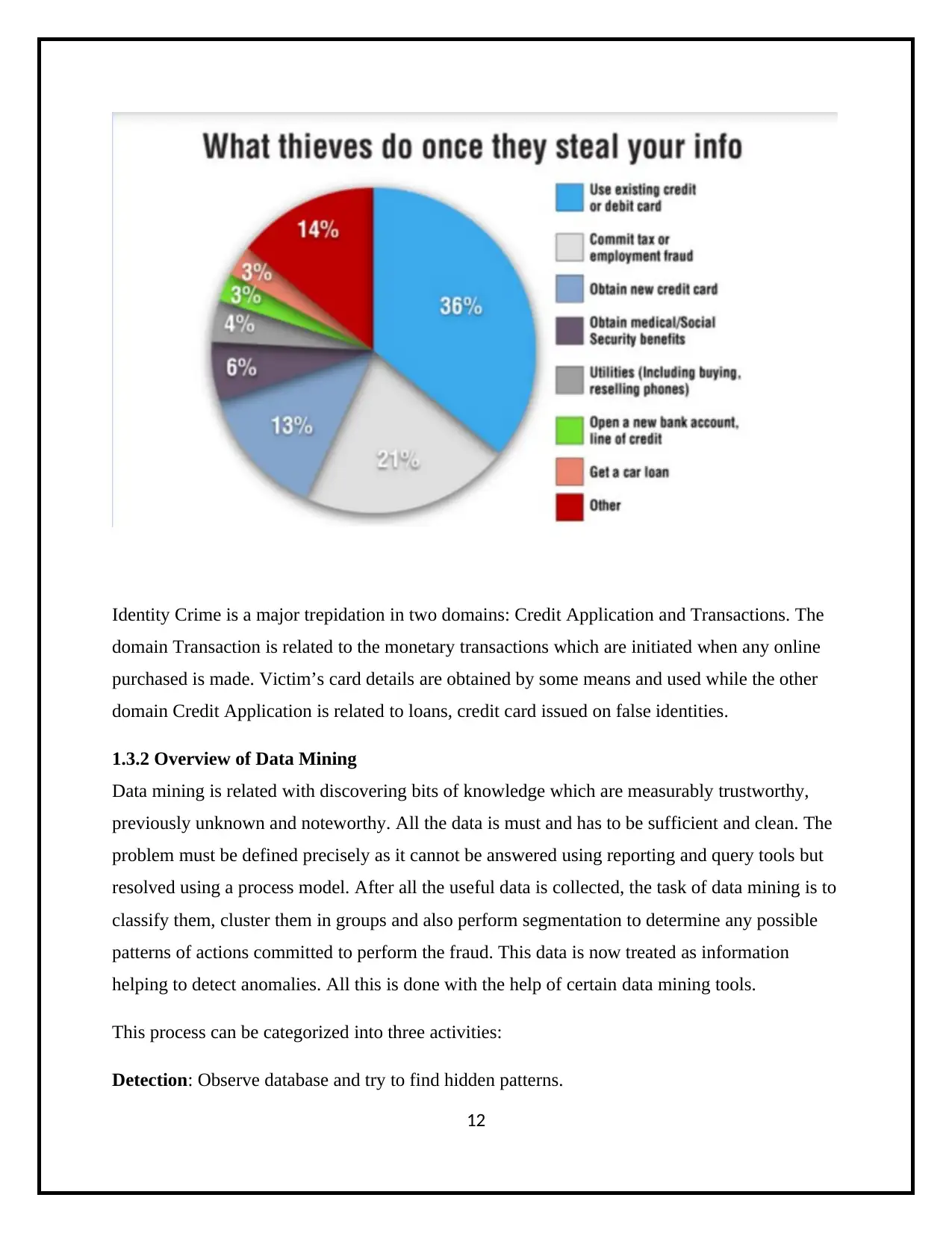
Identity Crime is a major trepidation in two domains: Credit Application and Transactions. The
domain Transaction is related to the monetary transactions which are initiated when any online
purchased is made. Victim’s card details are obtained by some means and used while the other
domain Credit Application is related to loans, credit card issued on false identities.
1.3.2 Overview of Data Mining
Data mining is related with discovering bits of knowledge which are measurably trustworthy,
previously unknown and noteworthy. All the data is must and has to be sufficient and clean. The
problem must be defined precisely as it cannot be answered using reporting and query tools but
resolved using a process model. After all the useful data is collected, the task of data mining is to
classify them, cluster them in groups and also perform segmentation to determine any possible
patterns of actions committed to perform the fraud. This data is now treated as information
helping to detect anomalies. All this is done with the help of certain data mining tools.
This process can be categorized into three activities:
Detection: Observe database and try to find hidden patterns.
12
domain Transaction is related to the monetary transactions which are initiated when any online
purchased is made. Victim’s card details are obtained by some means and used while the other
domain Credit Application is related to loans, credit card issued on false identities.
1.3.2 Overview of Data Mining
Data mining is related with discovering bits of knowledge which are measurably trustworthy,
previously unknown and noteworthy. All the data is must and has to be sufficient and clean. The
problem must be defined precisely as it cannot be answered using reporting and query tools but
resolved using a process model. After all the useful data is collected, the task of data mining is to
classify them, cluster them in groups and also perform segmentation to determine any possible
patterns of actions committed to perform the fraud. This data is now treated as information
helping to detect anomalies. All this is done with the help of certain data mining tools.
This process can be categorized into three activities:
Detection: Observe database and try to find hidden patterns.
12
Paraphrase This Document
Need a fresh take? Get an instant paraphrase of this document with our AI Paraphraser
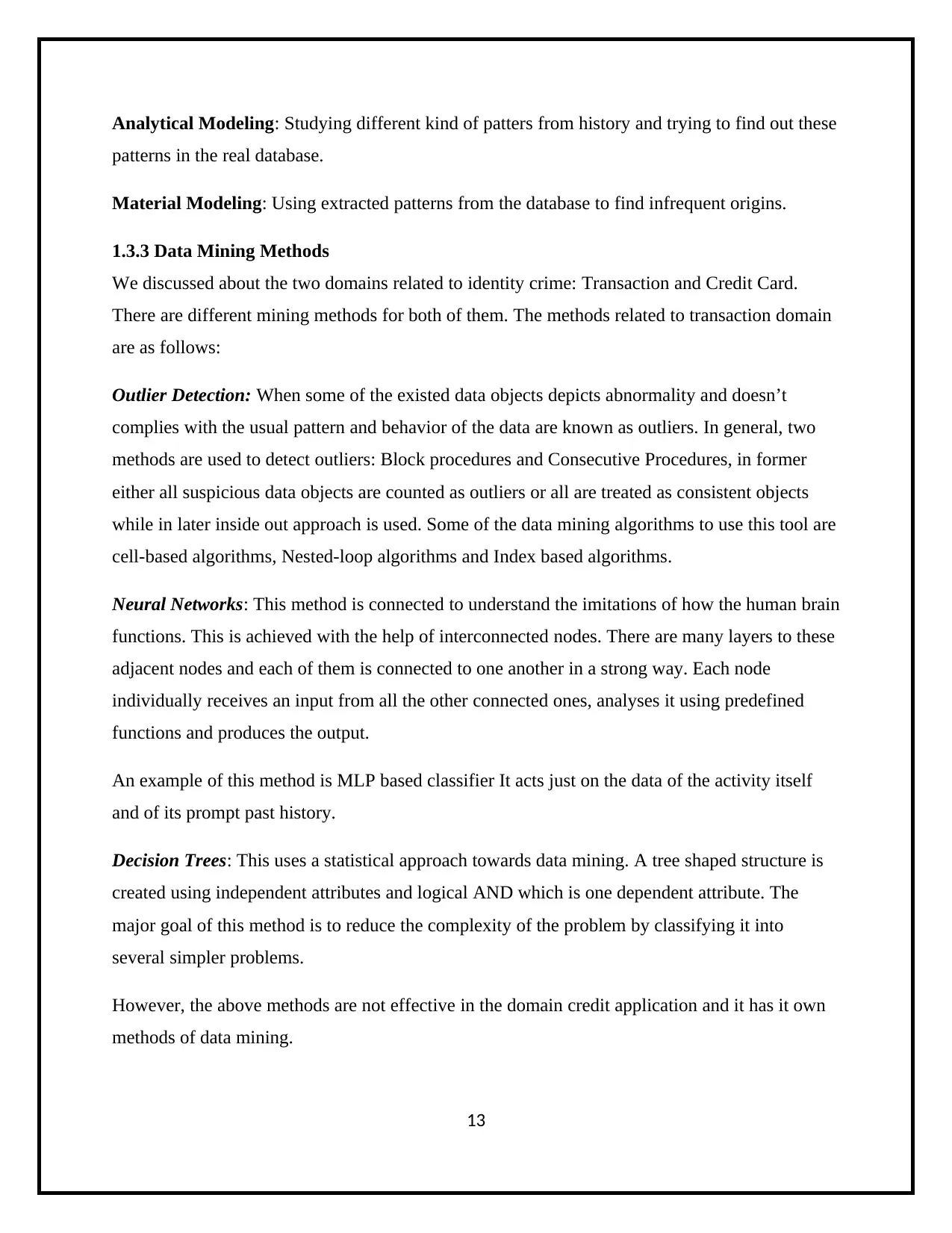
Analytical Modeling: Studying different kind of patters from history and trying to find out these
patterns in the real database.
Material Modeling: Using extracted patterns from the database to find infrequent origins.
1.3.3 Data Mining Methods
We discussed about the two domains related to identity crime: Transaction and Credit Card.
There are different mining methods for both of them. The methods related to transaction domain
are as follows:
Outlier Detection: When some of the existed data objects depicts abnormality and doesn’t
complies with the usual pattern and behavior of the data are known as outliers. In general, two
methods are used to detect outliers: Block procedures and Consecutive Procedures, in former
either all suspicious data objects are counted as outliers or all are treated as consistent objects
while in later inside out approach is used. Some of the data mining algorithms to use this tool are
cell-based algorithms, Nested-loop algorithms and Index based algorithms.
Neural Networks: This method is connected to understand the imitations of how the human brain
functions. This is achieved with the help of interconnected nodes. There are many layers to these
adjacent nodes and each of them is connected to one another in a strong way. Each node
individually receives an input from all the other connected ones, analyses it using predefined
functions and produces the output.
An example of this method is MLP based classifier It acts just on the data of the activity itself
and of its prompt past history.
Decision Trees: This uses a statistical approach towards data mining. A tree shaped structure is
created using independent attributes and logical AND which is one dependent attribute. The
major goal of this method is to reduce the complexity of the problem by classifying it into
several simpler problems.
However, the above methods are not effective in the domain credit application and it has it own
methods of data mining.
13
patterns in the real database.
Material Modeling: Using extracted patterns from the database to find infrequent origins.
1.3.3 Data Mining Methods
We discussed about the two domains related to identity crime: Transaction and Credit Card.
There are different mining methods for both of them. The methods related to transaction domain
are as follows:
Outlier Detection: When some of the existed data objects depicts abnormality and doesn’t
complies with the usual pattern and behavior of the data are known as outliers. In general, two
methods are used to detect outliers: Block procedures and Consecutive Procedures, in former
either all suspicious data objects are counted as outliers or all are treated as consistent objects
while in later inside out approach is used. Some of the data mining algorithms to use this tool are
cell-based algorithms, Nested-loop algorithms and Index based algorithms.
Neural Networks: This method is connected to understand the imitations of how the human brain
functions. This is achieved with the help of interconnected nodes. There are many layers to these
adjacent nodes and each of them is connected to one another in a strong way. Each node
individually receives an input from all the other connected ones, analyses it using predefined
functions and produces the output.
An example of this method is MLP based classifier It acts just on the data of the activity itself
and of its prompt past history.
Decision Trees: This uses a statistical approach towards data mining. A tree shaped structure is
created using independent attributes and logical AND which is one dependent attribute. The
major goal of this method is to reduce the complexity of the problem by classifying it into
several simpler problems.
However, the above methods are not effective in the domain credit application and it has it own
methods of data mining.
13
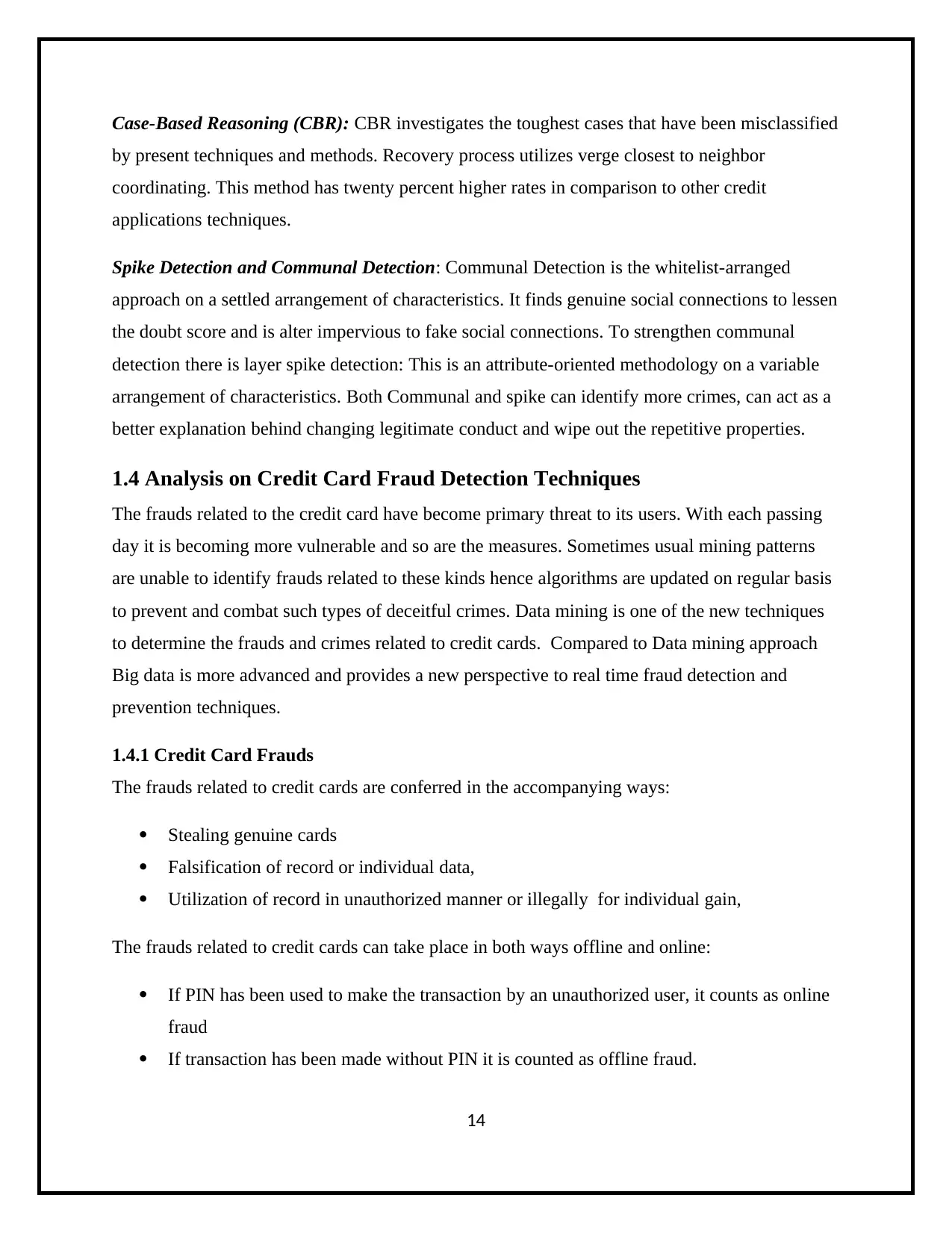
Case-Based Reasoning (CBR): CBR investigates the toughest cases that have been misclassified
by present techniques and methods. Recovery process utilizes verge closest to neighbor
coordinating. This method has twenty percent higher rates in comparison to other credit
applications techniques.
Spike Detection and Communal Detection: Communal Detection is the whitelist-arranged
approach on a settled arrangement of characteristics. It finds genuine social connections to lessen
the doubt score and is alter impervious to fake social connections. To strengthen communal
detection there is layer spike detection: This is an attribute-oriented methodology on a variable
arrangement of characteristics. Both Communal and spike can identify more crimes, can act as a
better explanation behind changing legitimate conduct and wipe out the repetitive properties.
1.4 Analysis on Credit Card Fraud Detection Techniques
The frauds related to the credit card have become primary threat to its users. With each passing
day it is becoming more vulnerable and so are the measures. Sometimes usual mining patterns
are unable to identify frauds related to these kinds hence algorithms are updated on regular basis
to prevent and combat such types of deceitful crimes. Data mining is one of the new techniques
to determine the frauds and crimes related to credit cards. Compared to Data mining approach
Big data is more advanced and provides a new perspective to real time fraud detection and
prevention techniques.
1.4.1 Credit Card Frauds
The frauds related to credit cards are conferred in the accompanying ways:
Stealing genuine cards
Falsification of record or individual data,
Utilization of record in unauthorized manner or illegally for individual gain,
The frauds related to credit cards can take place in both ways offline and online:
If PIN has been used to make the transaction by an unauthorized user, it counts as online
fraud
If transaction has been made without PIN it is counted as offline fraud.
14
by present techniques and methods. Recovery process utilizes verge closest to neighbor
coordinating. This method has twenty percent higher rates in comparison to other credit
applications techniques.
Spike Detection and Communal Detection: Communal Detection is the whitelist-arranged
approach on a settled arrangement of characteristics. It finds genuine social connections to lessen
the doubt score and is alter impervious to fake social connections. To strengthen communal
detection there is layer spike detection: This is an attribute-oriented methodology on a variable
arrangement of characteristics. Both Communal and spike can identify more crimes, can act as a
better explanation behind changing legitimate conduct and wipe out the repetitive properties.
1.4 Analysis on Credit Card Fraud Detection Techniques
The frauds related to the credit card have become primary threat to its users. With each passing
day it is becoming more vulnerable and so are the measures. Sometimes usual mining patterns
are unable to identify frauds related to these kinds hence algorithms are updated on regular basis
to prevent and combat such types of deceitful crimes. Data mining is one of the new techniques
to determine the frauds and crimes related to credit cards. Compared to Data mining approach
Big data is more advanced and provides a new perspective to real time fraud detection and
prevention techniques.
1.4.1 Credit Card Frauds
The frauds related to credit cards are conferred in the accompanying ways:
Stealing genuine cards
Falsification of record or individual data,
Utilization of record in unauthorized manner or illegally for individual gain,
The frauds related to credit cards can take place in both ways offline and online:
If PIN has been used to make the transaction by an unauthorized user, it counts as online
fraud
If transaction has been made without PIN it is counted as offline fraud.
14
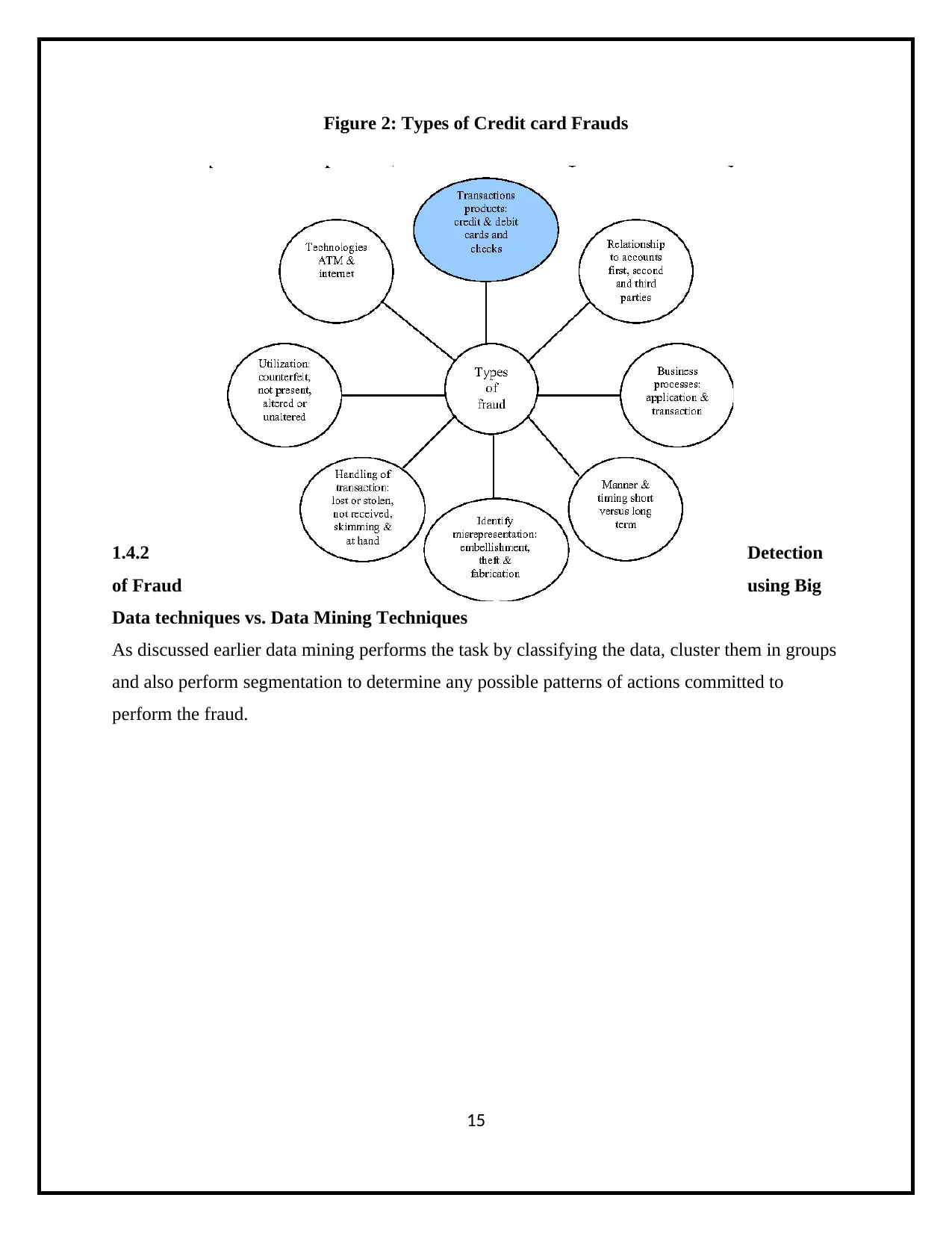
Figure 2: Types of Credit card Frauds
1.4.2 Detection
of Fraud using Big
Data techniques vs. Data Mining Techniques
As discussed earlier data mining performs the task by classifying the data, cluster them in groups
and also perform segmentation to determine any possible patterns of actions committed to
perform the fraud.
15
1.4.2 Detection
of Fraud using Big
Data techniques vs. Data Mining Techniques
As discussed earlier data mining performs the task by classifying the data, cluster them in groups
and also perform segmentation to determine any possible patterns of actions committed to
perform the fraud.
15
Secure Best Marks with AI Grader
Need help grading? Try our AI Grader for instant feedback on your assignments.
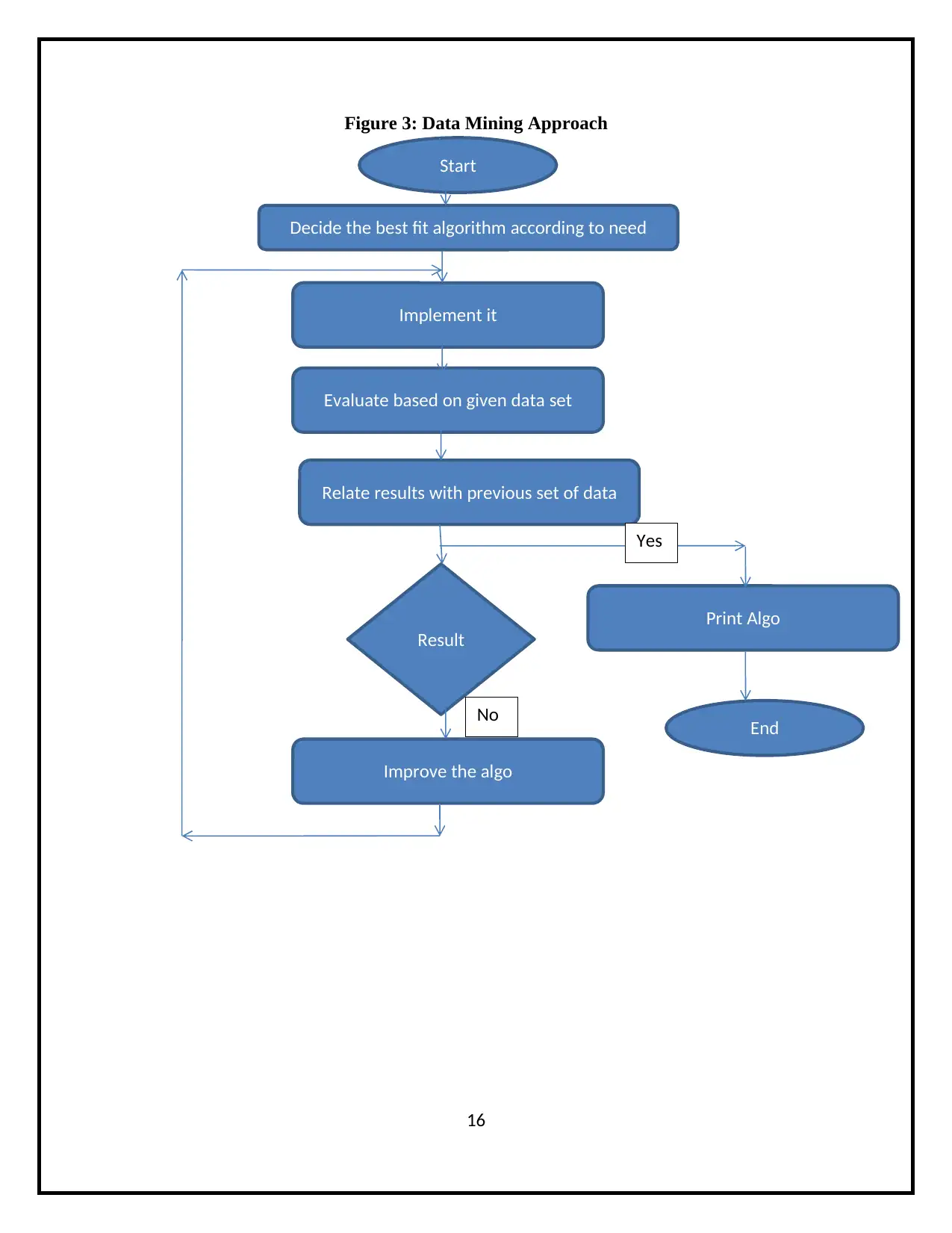
Figure 3: Data Mining Approach
16
Start
Decide the best fit algorithm according to need
Implement it
Evaluate based on given data set
Relate results with previous set of data
Result
Improve the algo
Print Algo
End
Yes
No
16
Start
Decide the best fit algorithm according to need
Implement it
Evaluate based on given data set
Relate results with previous set of data
Result
Improve the algo
Print Algo
End
Yes
No

17
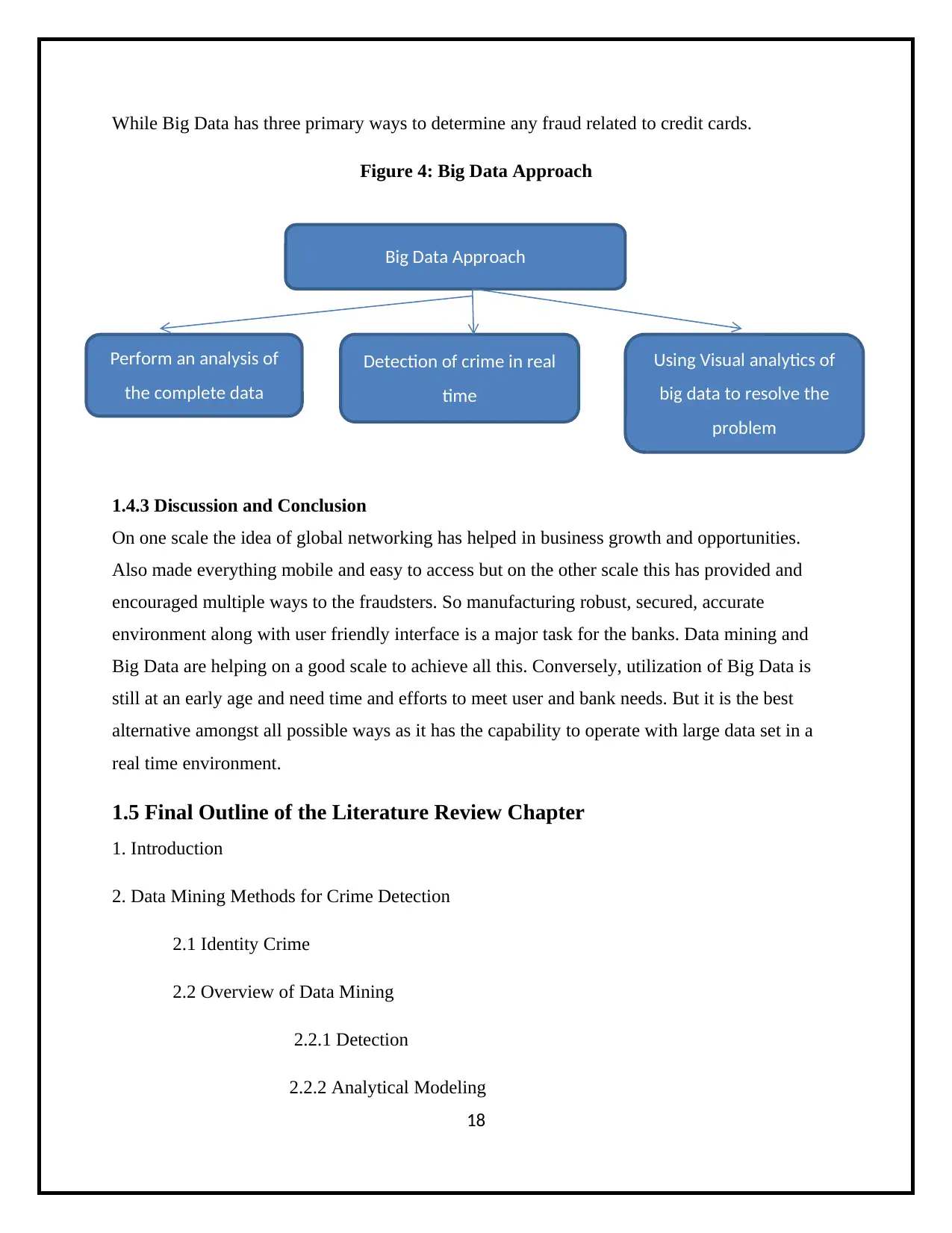
While Big Data has three primary ways to determine any fraud related to credit cards.
Figure 4: Big Data Approach
1.4.3 Discussion and Conclusion
On one scale the idea of global networking has helped in business growth and opportunities.
Also made everything mobile and easy to access but on the other scale this has provided and
encouraged multiple ways to the fraudsters. So manufacturing robust, secured, accurate
environment along with user friendly interface is a major task for the banks. Data mining and
Big Data are helping on a good scale to achieve all this. Conversely, utilization of Big Data is
still at an early age and need time and efforts to meet user and bank needs. But it is the best
alternative amongst all possible ways as it has the capability to operate with large data set in a
real time environment.
1.5 Final Outline of the Literature Review Chapter
1. Introduction
2. Data Mining Methods for Crime Detection
2.1 Identity Crime
2.2 Overview of Data Mining
2.2.1 Detection
2.2.2 Analytical Modeling
18
Big Data Approach
Perform an analysis of
the complete data
Detection of crime in real
time
Using Visual analytics of
big data to resolve the
problem
Figure 4: Big Data Approach
1.4.3 Discussion and Conclusion
On one scale the idea of global networking has helped in business growth and opportunities.
Also made everything mobile and easy to access but on the other scale this has provided and
encouraged multiple ways to the fraudsters. So manufacturing robust, secured, accurate
environment along with user friendly interface is a major task for the banks. Data mining and
Big Data are helping on a good scale to achieve all this. Conversely, utilization of Big Data is
still at an early age and need time and efforts to meet user and bank needs. But it is the best
alternative amongst all possible ways as it has the capability to operate with large data set in a
real time environment.
1.5 Final Outline of the Literature Review Chapter
1. Introduction
2. Data Mining Methods for Crime Detection
2.1 Identity Crime
2.2 Overview of Data Mining
2.2.1 Detection
2.2.2 Analytical Modeling
18
Big Data Approach
Perform an analysis of
the complete data
Detection of crime in real
time
Using Visual analytics of
big data to resolve the
problem
Paraphrase This Document
Need a fresh take? Get an instant paraphrase of this document with our AI Paraphraser
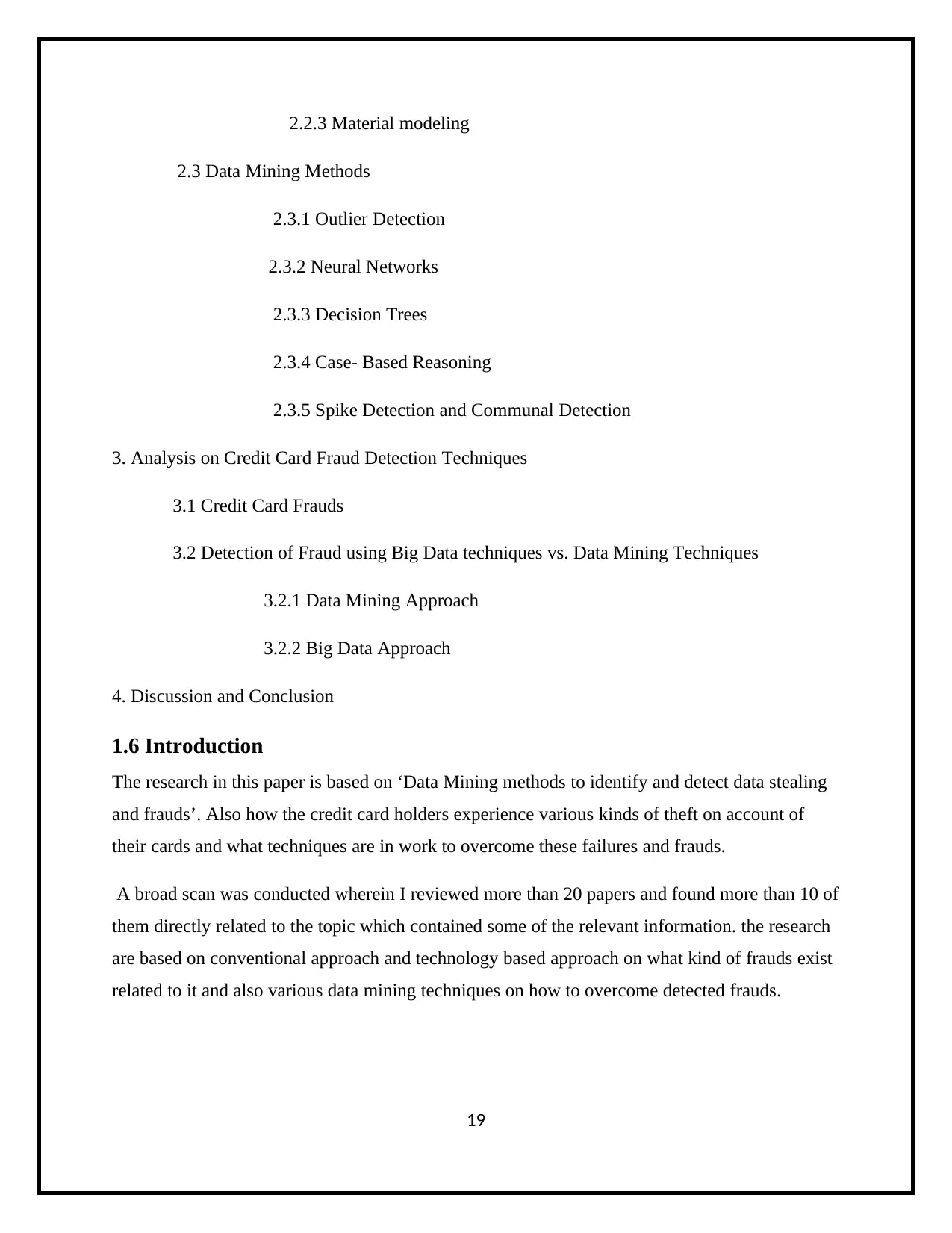
2.2.3 Material modeling
2.3 Data Mining Methods
2.3.1 Outlier Detection
2.3.2 Neural Networks
2.3.3 Decision Trees
2.3.4 Case- Based Reasoning
2.3.5 Spike Detection and Communal Detection
3. Analysis on Credit Card Fraud Detection Techniques
3.1 Credit Card Frauds
3.2 Detection of Fraud using Big Data techniques vs. Data Mining Techniques
3.2.1 Data Mining Approach
3.2.2 Big Data Approach
4. Discussion and Conclusion
1.6 Introduction
The research in this paper is based on ‘Data Mining methods to identify and detect data stealing
and frauds’. Also how the credit card holders experience various kinds of theft on account of
their cards and what techniques are in work to overcome these failures and frauds.
A broad scan was conducted wherein I reviewed more than 20 papers and found more than 10 of
them directly related to the topic which contained some of the relevant information. the research
are based on conventional approach and technology based approach on what kind of frauds exist
related to it and also various data mining techniques on how to overcome detected frauds.
19
2.3 Data Mining Methods
2.3.1 Outlier Detection
2.3.2 Neural Networks
2.3.3 Decision Trees
2.3.4 Case- Based Reasoning
2.3.5 Spike Detection and Communal Detection
3. Analysis on Credit Card Fraud Detection Techniques
3.1 Credit Card Frauds
3.2 Detection of Fraud using Big Data techniques vs. Data Mining Techniques
3.2.1 Data Mining Approach
3.2.2 Big Data Approach
4. Discussion and Conclusion
1.6 Introduction
The research in this paper is based on ‘Data Mining methods to identify and detect data stealing
and frauds’. Also how the credit card holders experience various kinds of theft on account of
their cards and what techniques are in work to overcome these failures and frauds.
A broad scan was conducted wherein I reviewed more than 20 papers and found more than 10 of
them directly related to the topic which contained some of the relevant information. the research
are based on conventional approach and technology based approach on what kind of frauds exist
related to it and also various data mining techniques on how to overcome detected frauds.
19
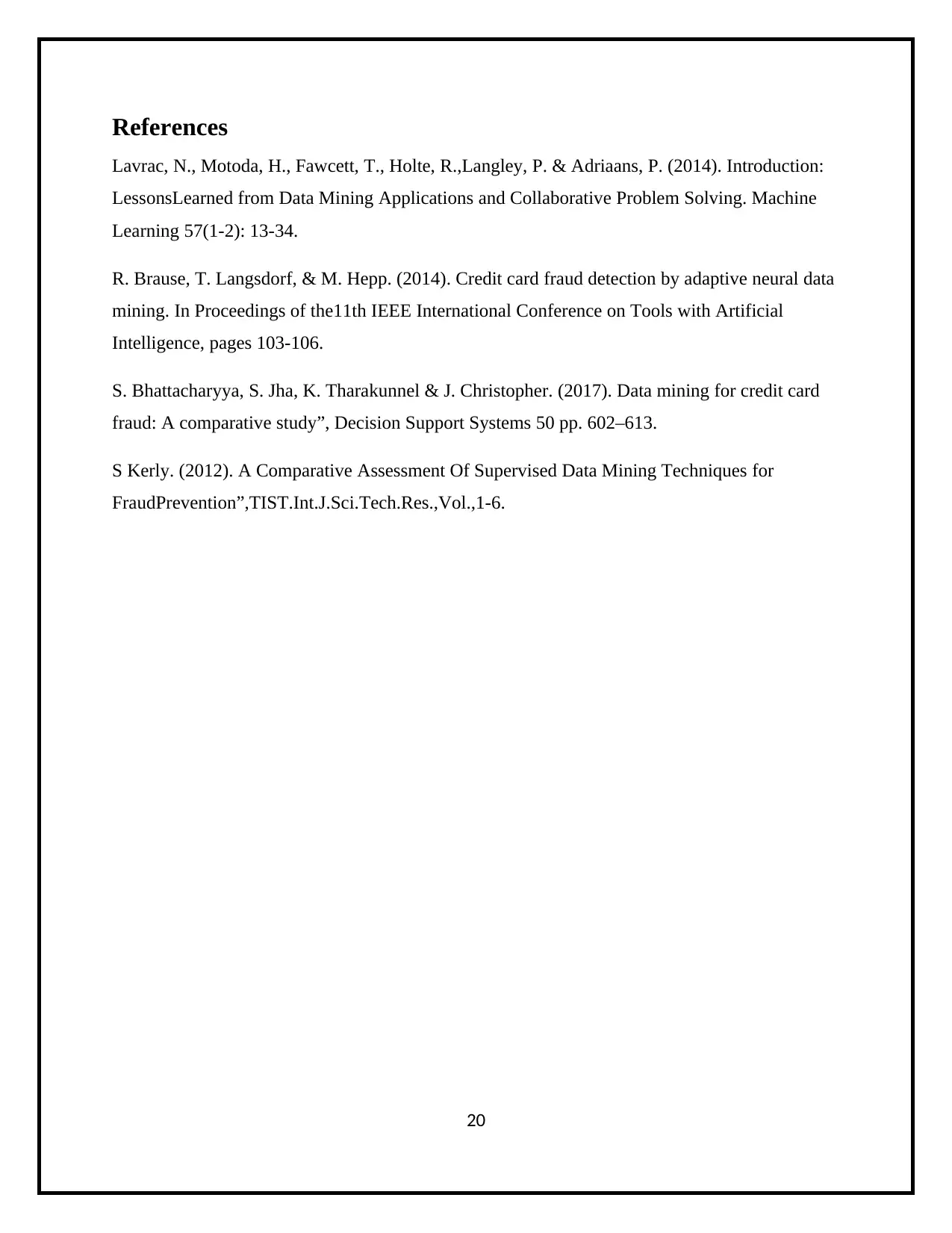
References
Lavrac, N., Motoda, H., Fawcett, T., Holte, R.,Langley, P. & Adriaans, P. (2014). Introduction:
LessonsLearned from Data Mining Applications and Collaborative Problem Solving. Machine
Learning 57(1-2): 13-34.
R. Brause, T. Langsdorf, & M. Hepp. (2014). Credit card fraud detection by adaptive neural data
mining. In Proceedings of the11th IEEE International Conference on Tools with Artificial
Intelligence, pages 103-106.
S. Bhattacharyya, S. Jha, K. Tharakunnel & J. Christopher. (2017). Data mining for credit card
fraud: A comparative study”, Decision Support Systems 50 pp. 602–613.
S Kerly. (2012). A Comparative Assessment Of Supervised Data Mining Techniques for
FraudPrevention”,TIST.Int.J.Sci.Tech.Res.,Vol.,1-6.
20
Lavrac, N., Motoda, H., Fawcett, T., Holte, R.,Langley, P. & Adriaans, P. (2014). Introduction:
LessonsLearned from Data Mining Applications and Collaborative Problem Solving. Machine
Learning 57(1-2): 13-34.
R. Brause, T. Langsdorf, & M. Hepp. (2014). Credit card fraud detection by adaptive neural data
mining. In Proceedings of the11th IEEE International Conference on Tools with Artificial
Intelligence, pages 103-106.
S. Bhattacharyya, S. Jha, K. Tharakunnel & J. Christopher. (2017). Data mining for credit card
fraud: A comparative study”, Decision Support Systems 50 pp. 602–613.
S Kerly. (2012). A Comparative Assessment Of Supervised Data Mining Techniques for
FraudPrevention”,TIST.Int.J.Sci.Tech.Res.,Vol.,1-6.
20
1 out of 21
Related Documents
Your All-in-One AI-Powered Toolkit for Academic Success.
+13062052269
info@desklib.com
Available 24*7 on WhatsApp / Email
![[object Object]](/_next/static/media/star-bottom.7253800d.svg)
Unlock your academic potential
© 2024 | Zucol Services PVT LTD | All rights reserved.





